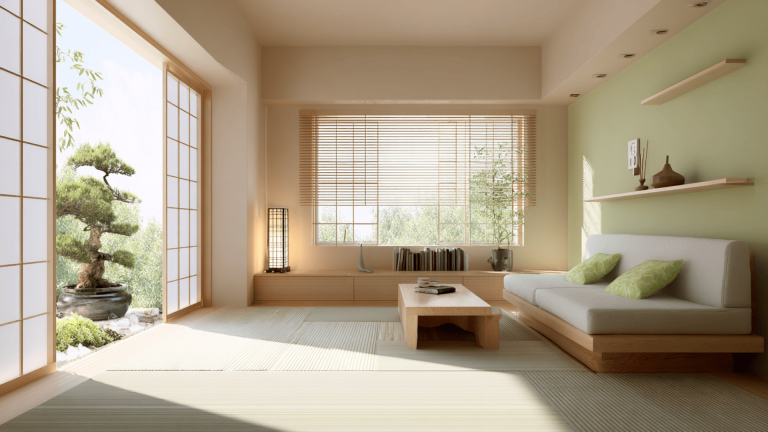I realized that a Japanese-style living room was the ideal choice when I wanted my home to feel peaceful and welcoming.
Maybe you’re looking for the same clean lines, natural materials, and an open layout that feels both peaceful and practical. Many of us want a living room that’s beautiful yet easy to live in every day, and this style delivers exactly that.
I’ll walk you through the key design principles to follow and plenty of ideas to inspire you. You’ll also get simple tips for keeping the space fresh over time.
Let’s get started and help you create a simple, comfortable room.
What Makes a Living Room Japanese Style?
A Japanese-style living room is peaceful, simple, and functional, using natural materials, open space, and a strong connection to nature.
It reflects Japan’s cultural values of harmony, balance, and minimal living, where every item has a purpose and the space feels uncluttered.
Traditional designs feature tatami mats, sliding shoji screens, low furniture, and minimal decor such as a tokonoma alcove for art or flowers.
Modern versions keep the clean lines and simplicity but add comfort upgrades, mixing tatami with wood or laminate floors, using modern lighting and technology, and sometimes blending with other styles like Scandinavian to create Japandi.
Core Design Principles
The Japanese-style follows three main principles that shape its look and feel. These elements help create a space that is peaceful, practical, and connected to nature:
1. Minimalism & Open Space
Furniture and decor are kept to a minimum to avoid clutter. Open areas allow light and air to flow freely, making the room feel larger and more peaceful.
This simplicity also makes cleaning and maintaining the space much easier.
2. Harmony with Nature
Natural materials like wood, bamboo, and stone are common. Large windows, plants, and soft lighting bring the outdoors inside and create a balanced atmosphere.
This connection to nature helps reduce stress and encourages relaxation.
3. Functionality & Multipurpose Layouts
Every piece of furniture serves a purpose, often with more than one function. Sliding doors, foldable furniture, and hidden storage make the space adaptable for different needs.
This approach ensures the room stays tidy and useful without sacrificing style.
Japanese Style Living Room Ideas to Try
A Japanese-style living room blends comfort, simplicity, and cultural tradition. These ideas combine classic elements with modern updates to create a peaceful, inviting space:
1. A Low-Profile Sofa for Floor-Centric Seating
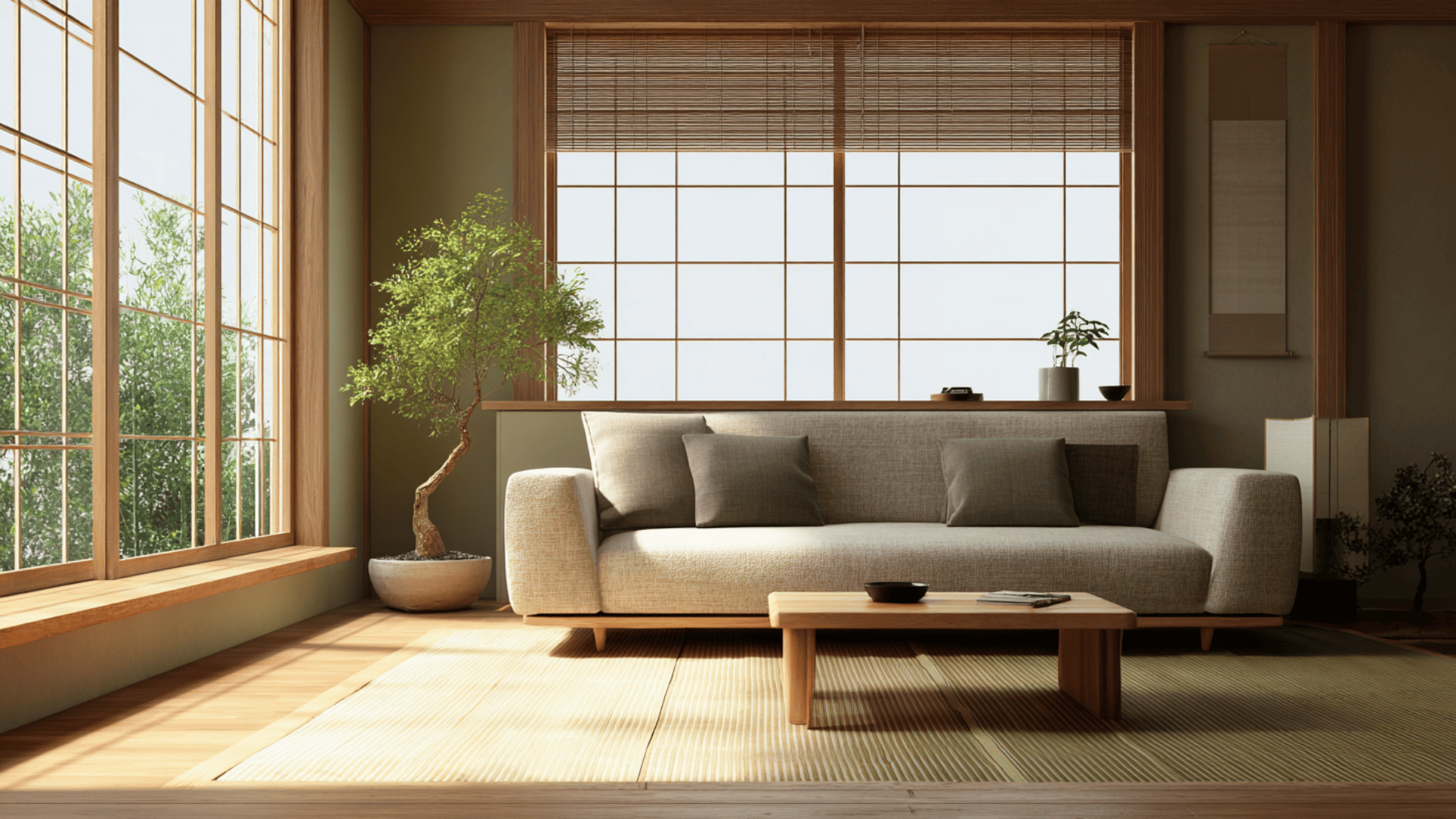
A low sofa keeps seating close to the ground, which is a key feature of Japanese interiors. Choose a design with clean lines, neutral fabric, and minimal legs so it feels grounded and open.
Pair it with a small coffee table to keep proportions balanced. This setup makes the space feel relaxed, airy, and connected to the floor.
2. Shoji Screens for Soft Light and Privacy
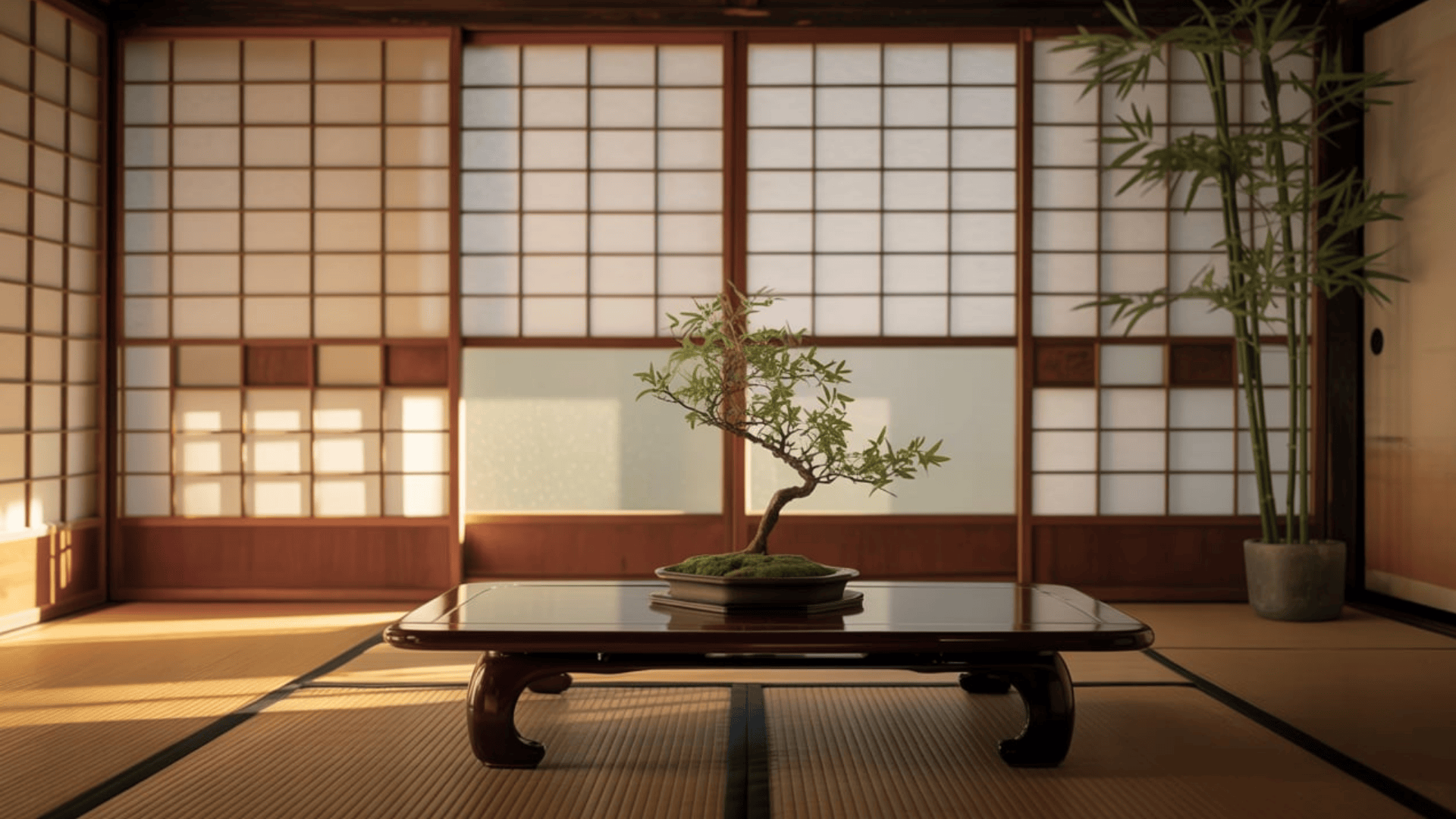
Shoji screens are wooden frames filled with translucent paper that let in soft, natural light. They can replace curtains or serve as stylish room dividers.
The light they filter feels warm and peaceful, and they provide privacy without closing off the space. This keeps the room bright.
3. A Kotatsu Table for Cozy Winter Gatherings
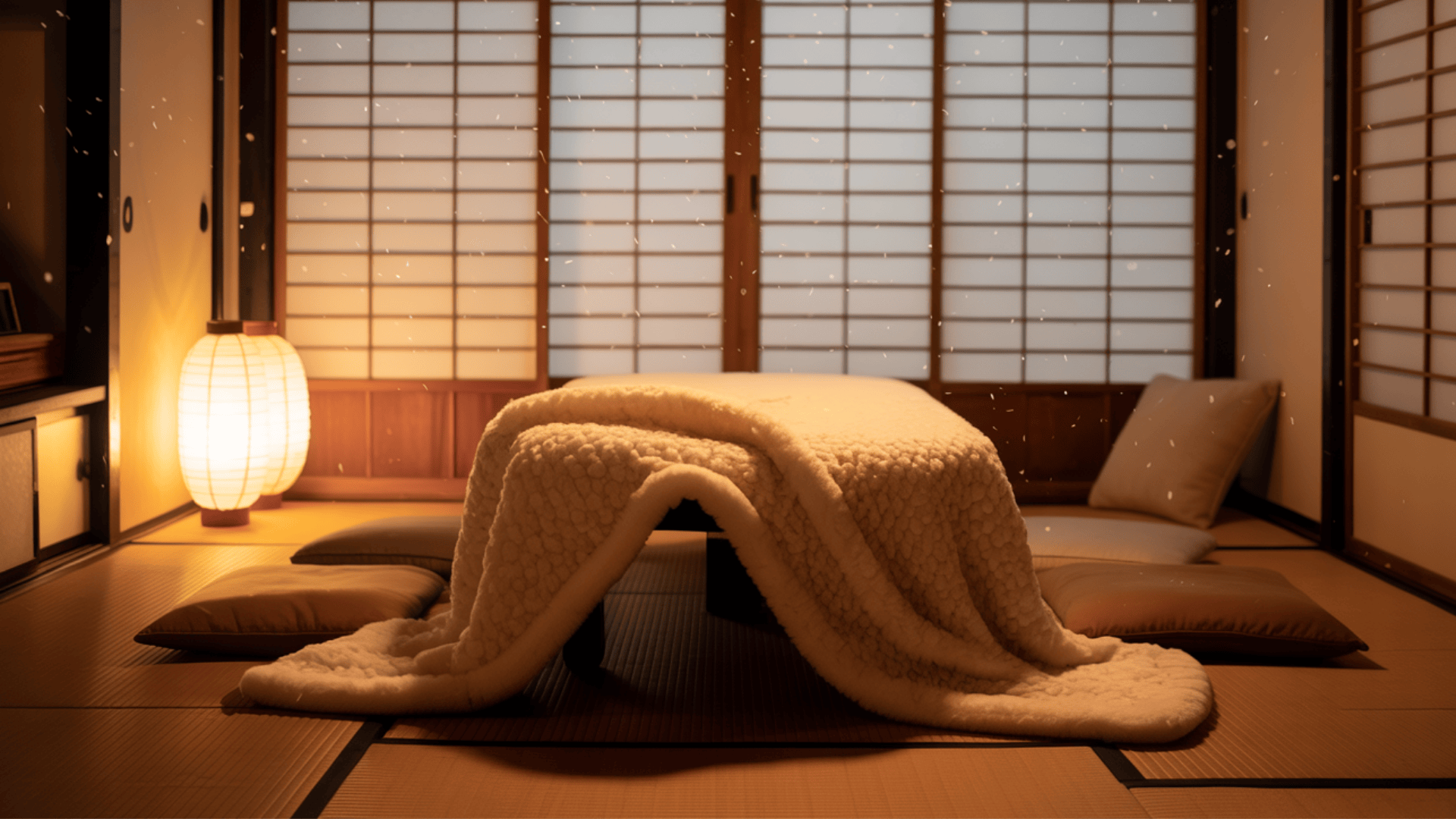
A kotatsu table has a low wooden frame, a thick blanket, and a heater underneath. It’s perfect for cold months when you want to sit comfortably on floor cushions.
Use it for meals, tea, reading, or simply relaxing with family. It brings warmth and a sense of togetherness to the living room.
4. Neutral, Nature-Inspired Color Palette
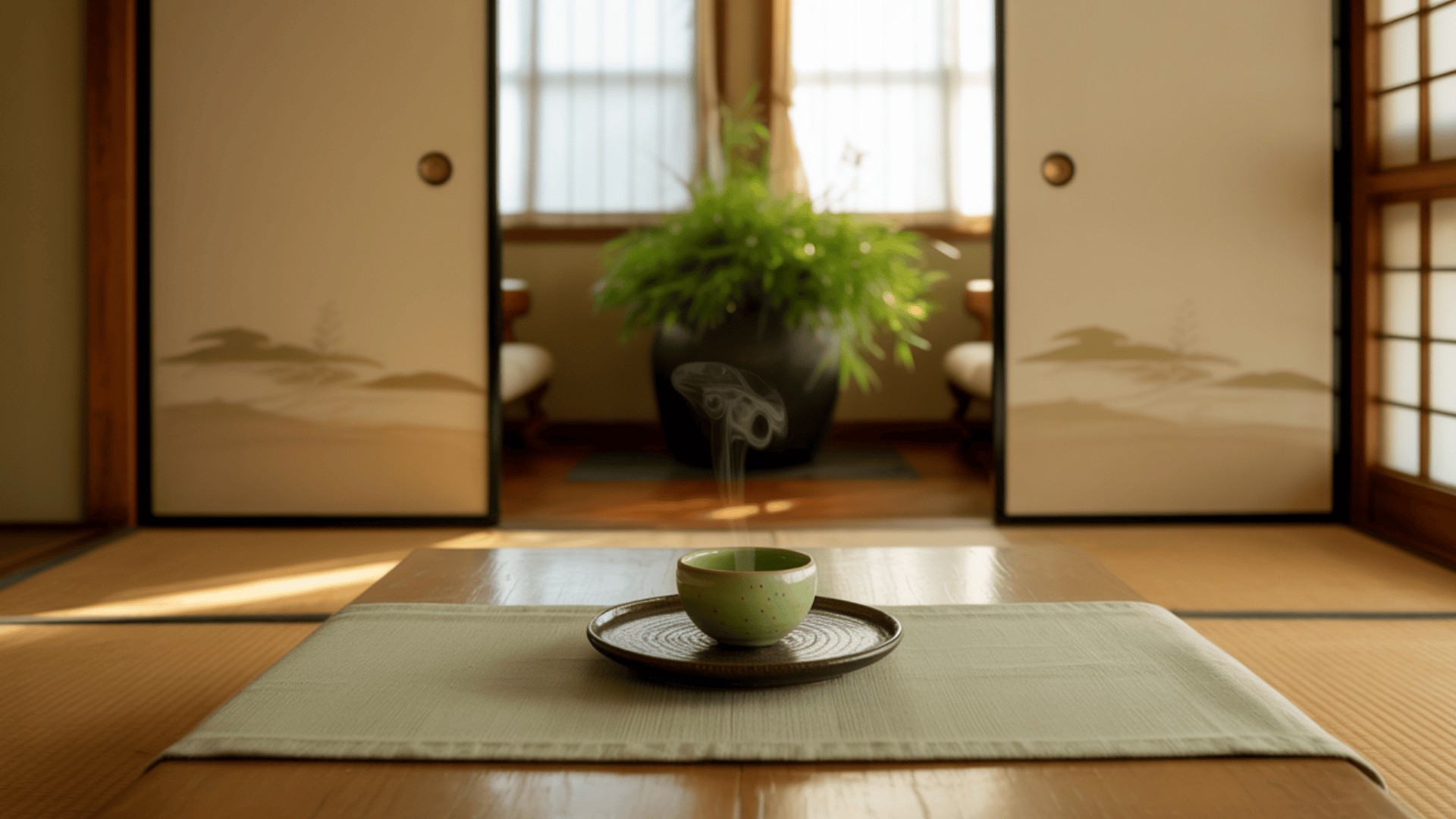
Soft tones like beige, cream, and muted green create a peaceful backdrop. These colors work well for walls, furniture, and rugs, complementing natural materials like wood and stone.
Darker browns or charcoal can be added in small amounts for depth. A neutral palette makes the space feel balanced and restful.
5. Bonsai Trees as a Living Art Element
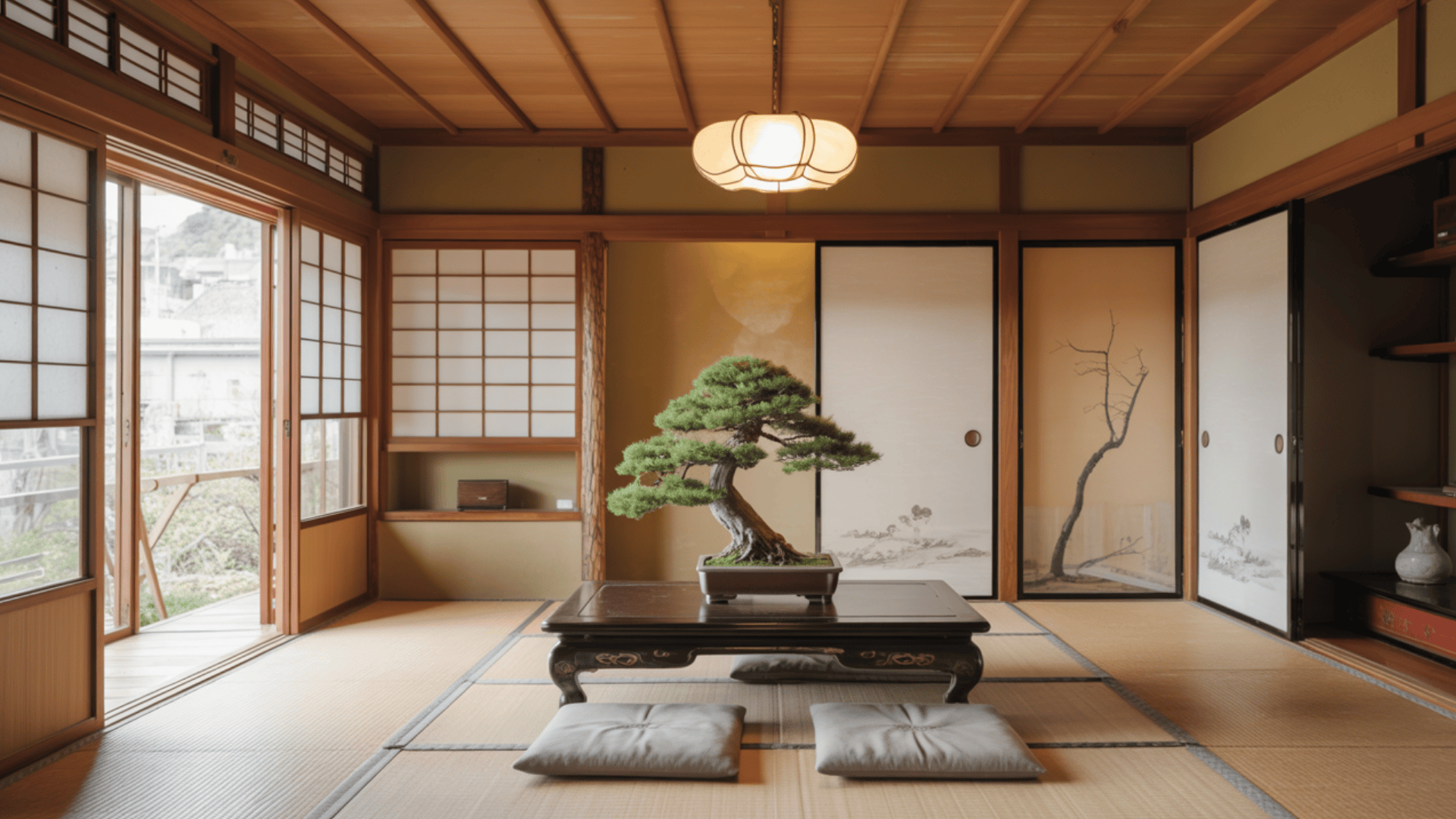
A bonsai tree is a miniature plant shaped to mimic full-size trees in nature. Place one on a low table, shelf, or windowsill where it can get enough light.
Different species offer different looks, so choose one that fits your space and care level. A bonsai brings life, beauty, and cultural depth to the room.
6. Bamboo Blinds for Natural Window Coverings
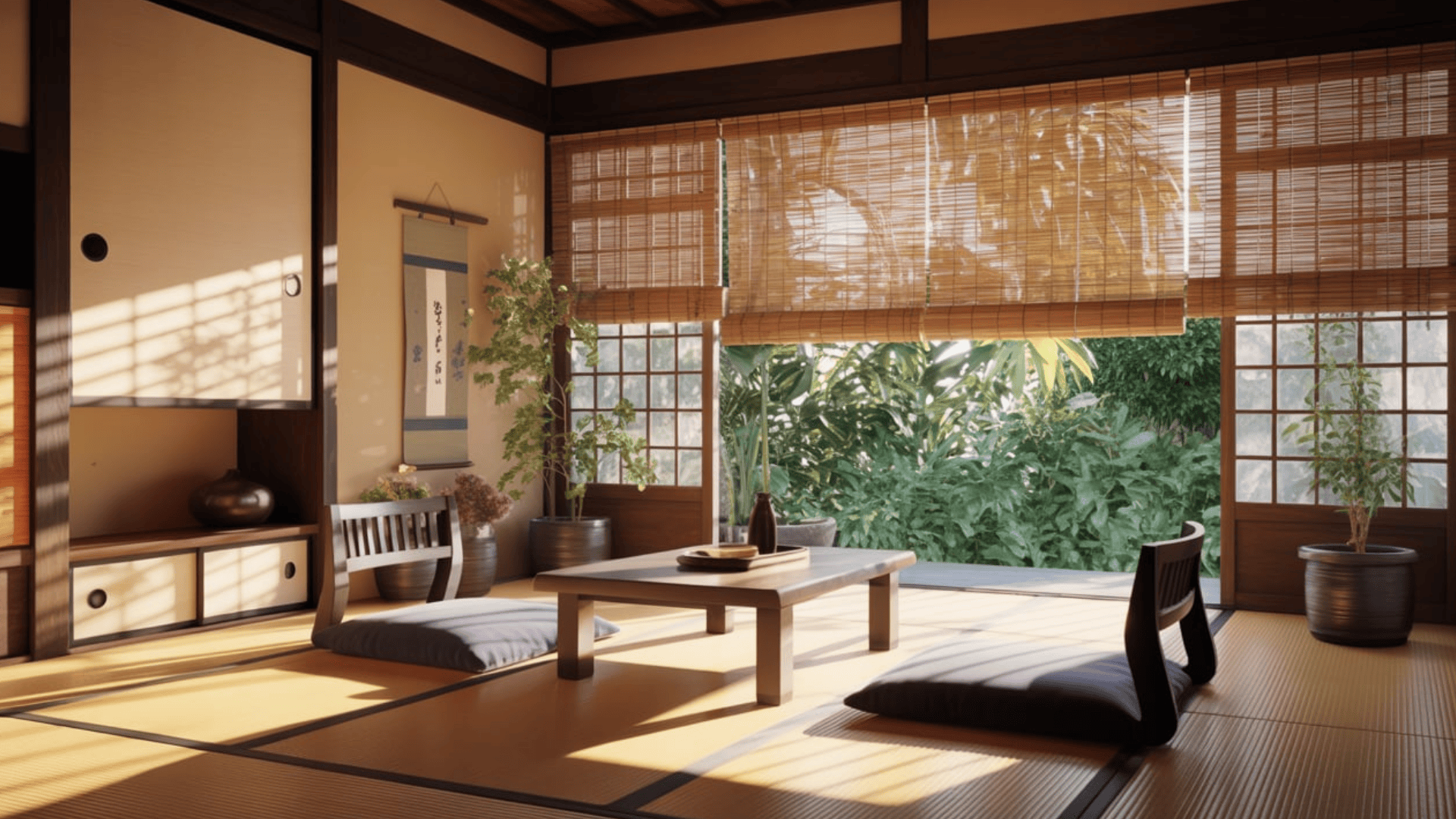
Bamboo blinds are light, breathable, and fit seamlessly into a Japanese-inspired design. They filter sunlight softly while adding warmth and texture to the space.
Use them on large windows or sliding doors to connect with the outdoors. Their natural look blends easily with wood and other organic materials.
7. A Tokonoma Alcove to Showcase Art or Flowers
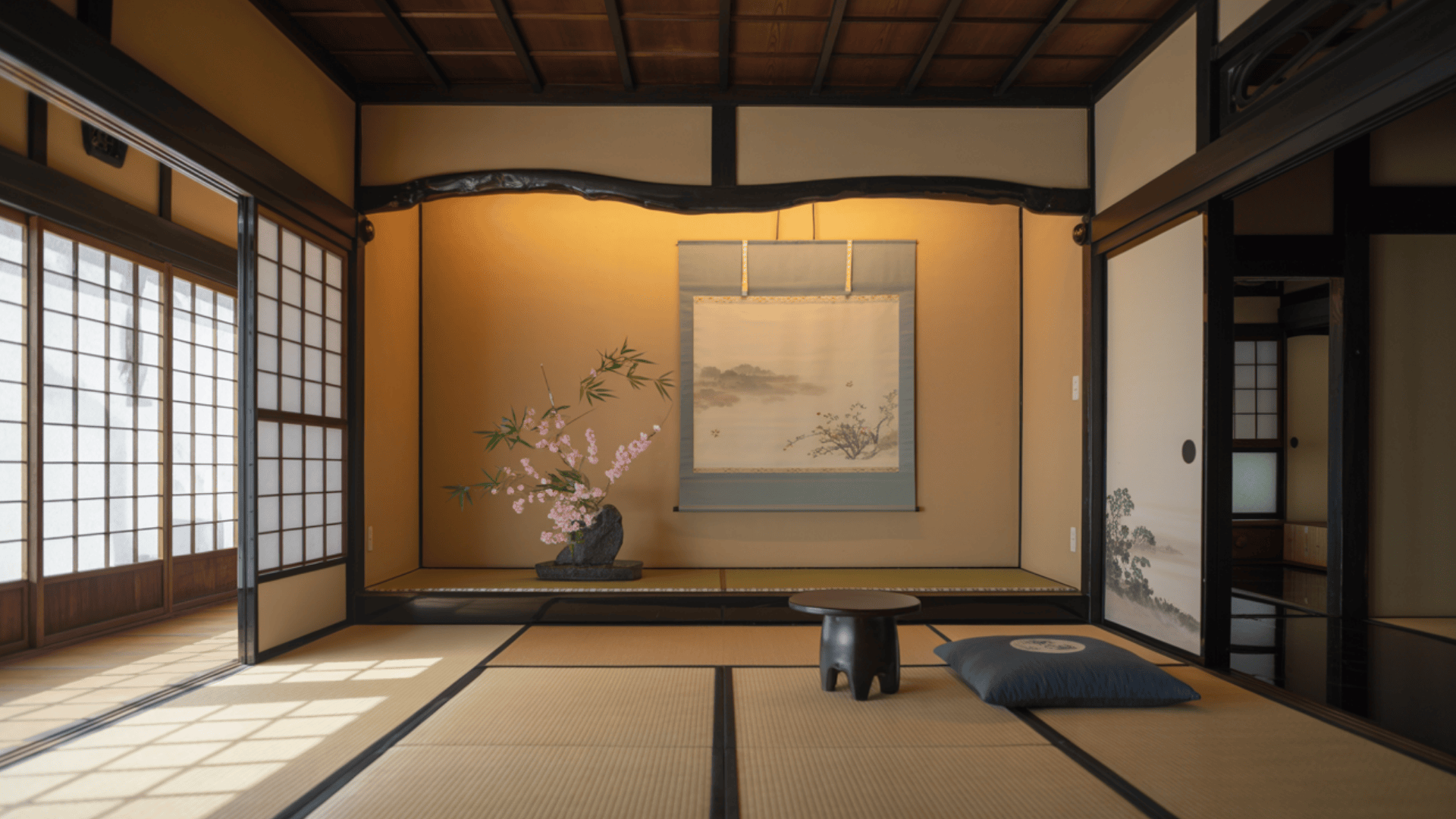
A tokonoma is a recessed display space often found in traditional Japanese rooms. It is used to highlight a single piece of art, a flower arrangement, or a small sculpture.
Keep the display minimal so the focus stays on the chosen item. This small feature adds cultural authenticity and elegance to your living room.
8. Built-In Storage to Hide Clutter
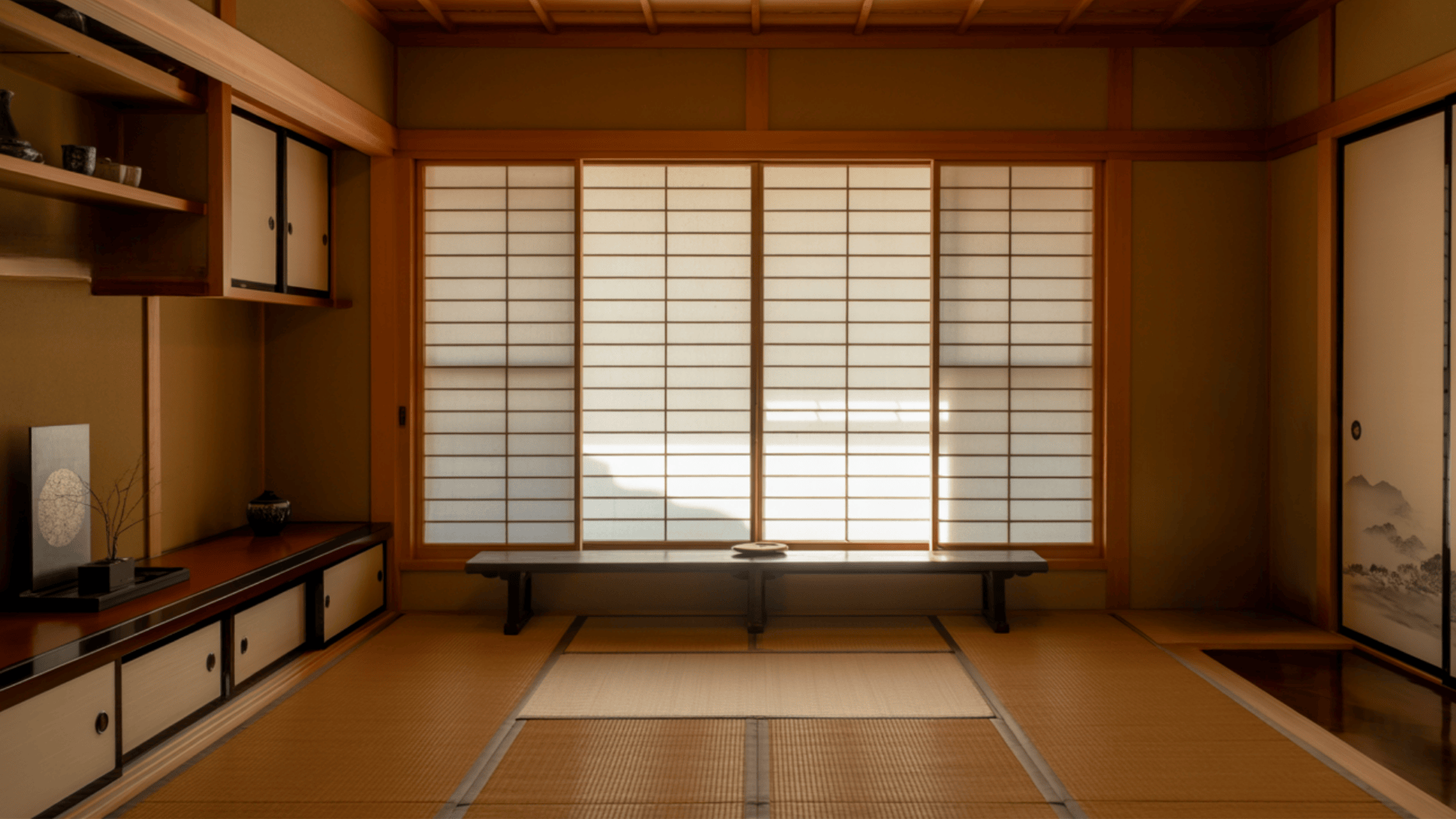
Built-in shelves, benches, or wall cabinets help maintain a clean, uncluttered look. Store books, electronics, and other items out of sight to preserve the room’s open feel.
Pick finishes that match the floor or wall color so the storage blends in. This keeps the room looking calm and balanced.
9. Layered Floor Cushions for Casual Seating
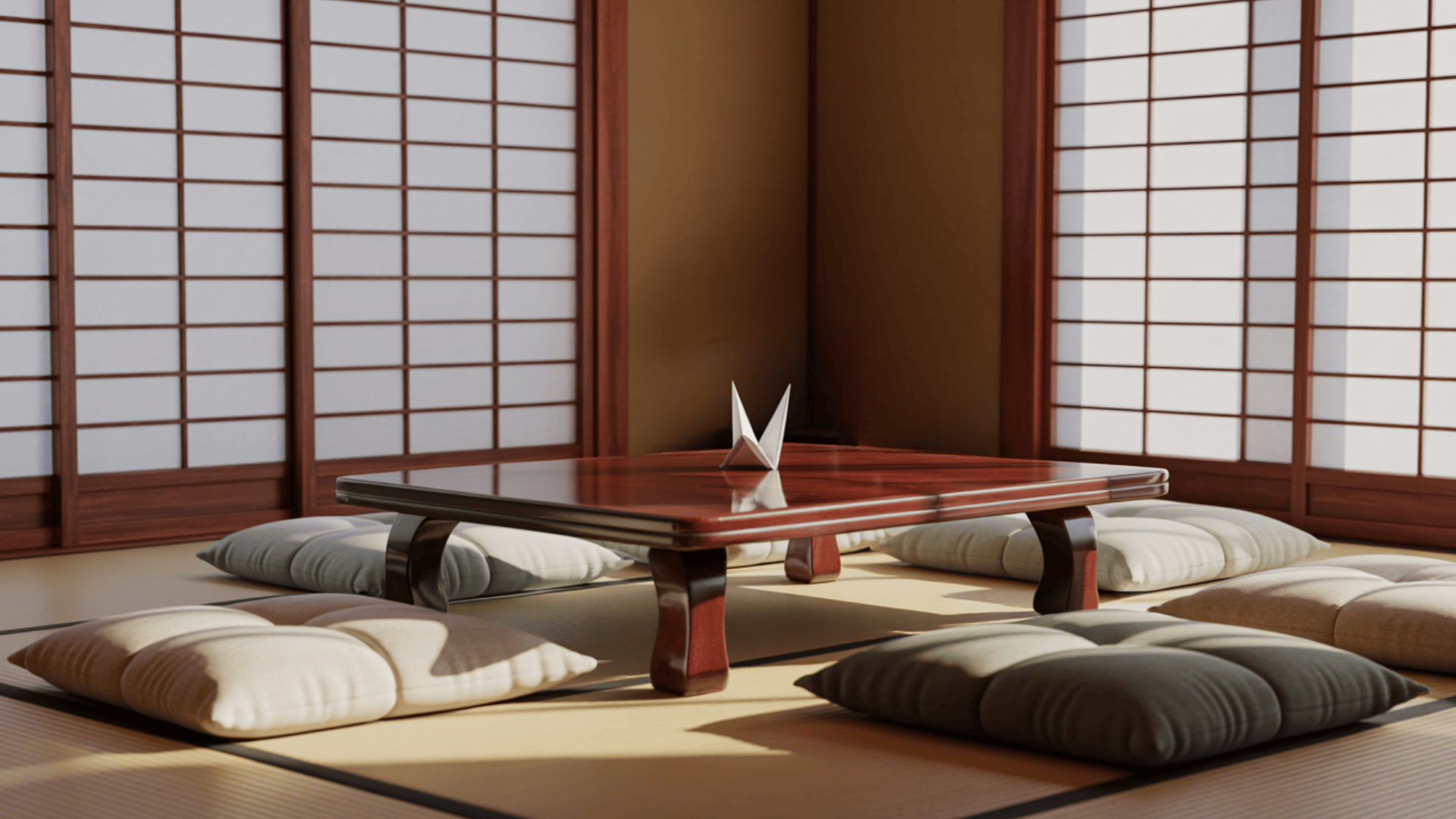
Floor cushions, or zabuton, are versatile seating options that can be stacked when not in use. Keep them in soft, muted colors that match the rest of the room.
They’re perfect for guests, casual meals, or tea time around a low table. This seating style adds flexibility without taking up much space.
10. Sliding Doors to Save Space
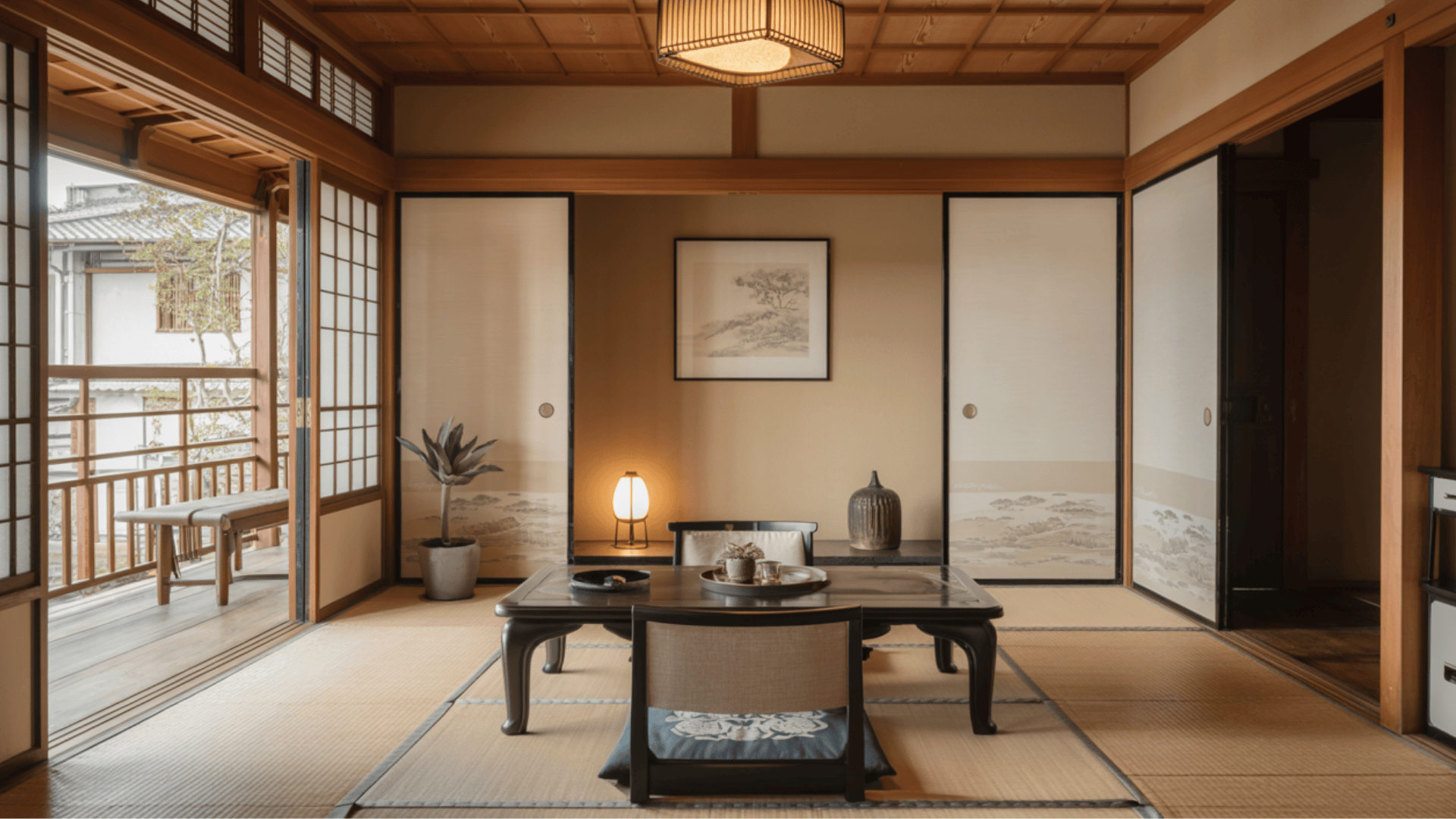
Sliding doors, no matter if it’s traditional shoji or modern glass, move along a track instead of swinging open. They’re ideal for smaller living rooms because they free up floor space.
Choose materials that match your room’s overall style for a cohesive look. These doors keep the layout open while offering privacy when needed.
11. Rattan or Wicker Accent Chairs
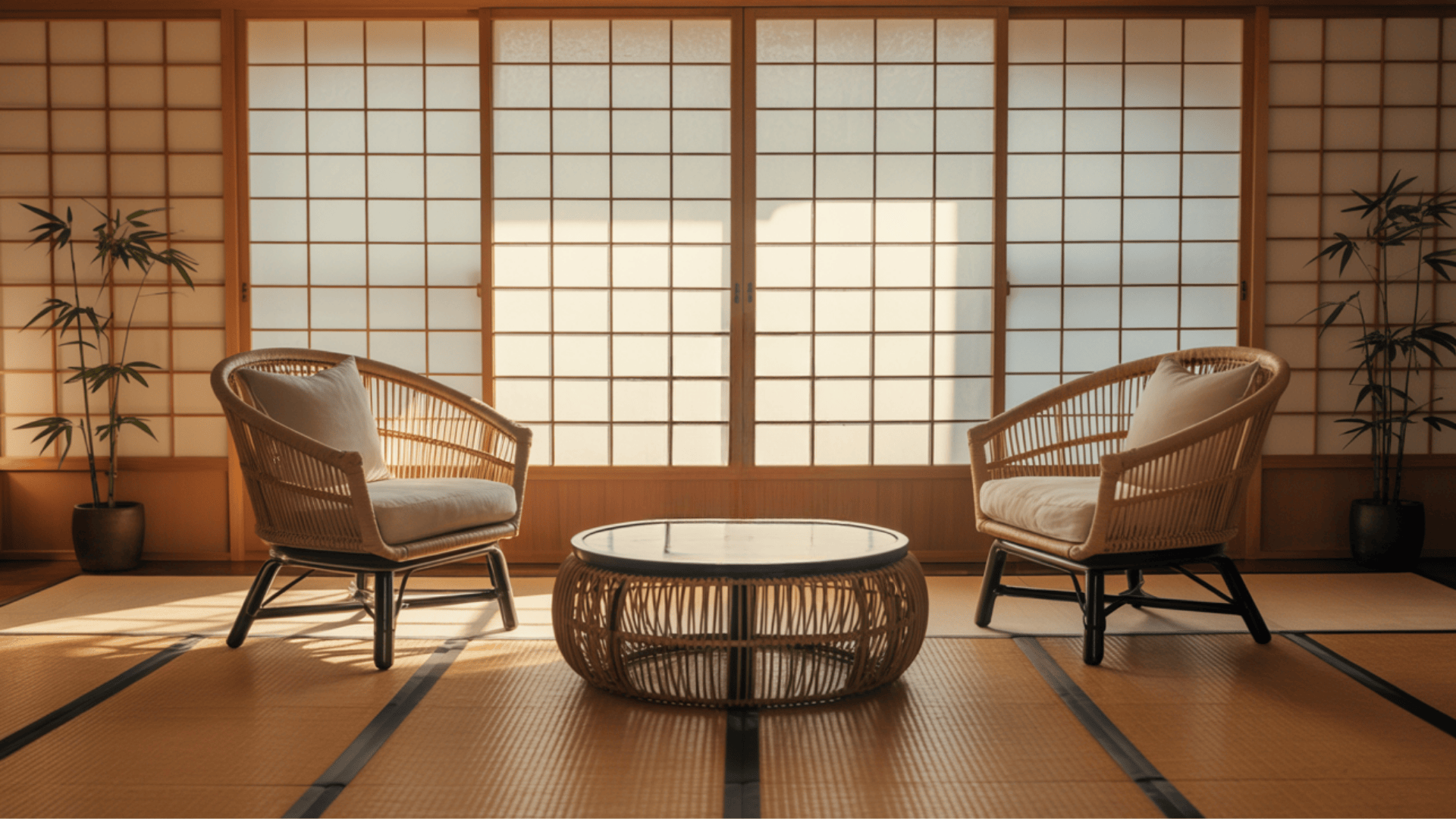
Rattan and wicker chairs add warmth and texture to a Japanese-style living room. Choose designs with a low profile to match the rest of your seating.
Neutral cushions keep the look soft and understated. These chairs are lightweight, making them easy to move around for extra seating when needed.
12. Washi Paper Lamps for Warm Light
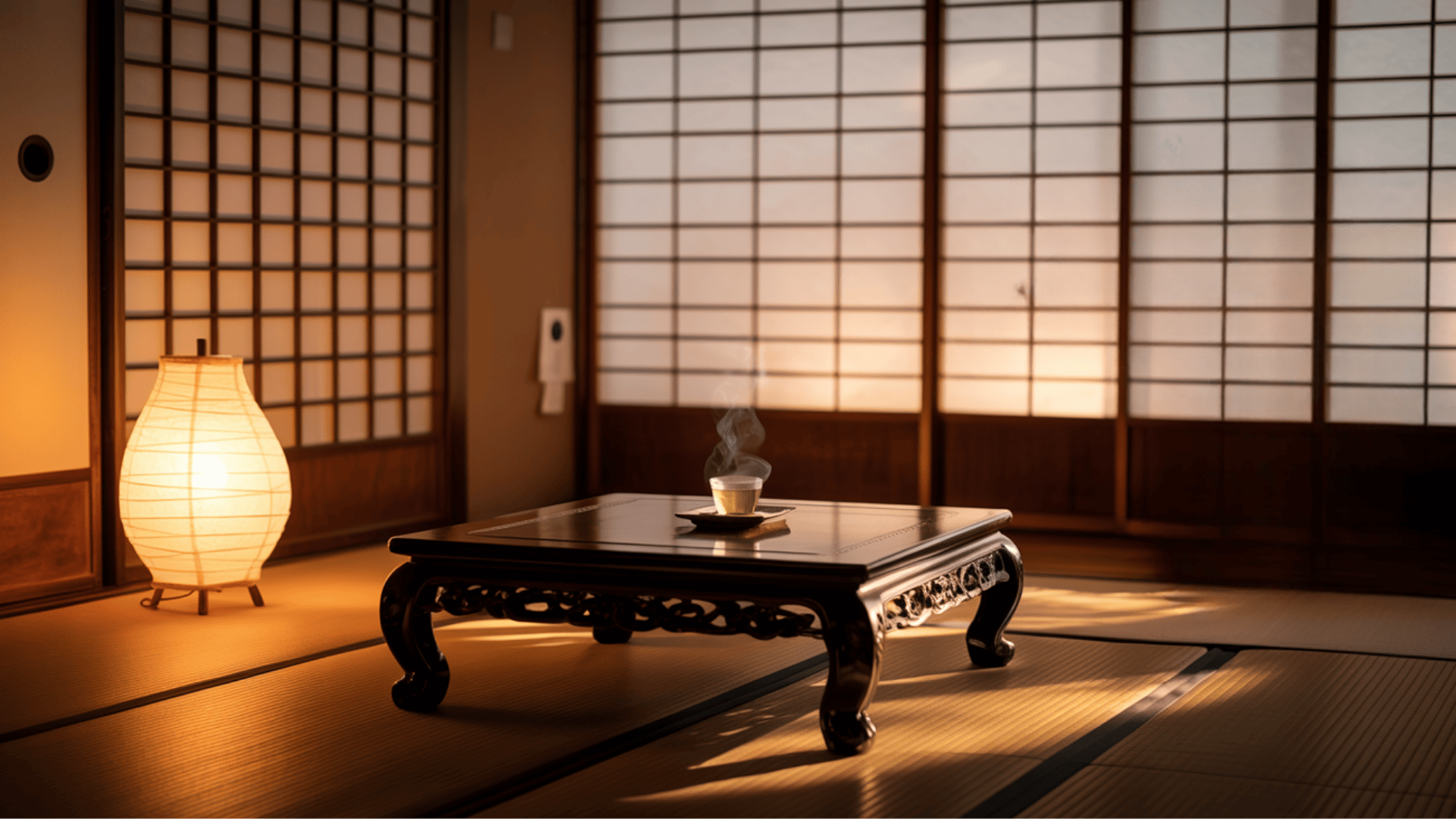
Washi paper lamps create a soft, diffused glow that makes a room feel cozy. They work well as table lamps, floor lamps, or hanging lanterns.
The gentle light complements natural materials like wood and bamboo. This style of lighting keeps the mood peaceful and inviting.
13. Low and Horizontal Decor
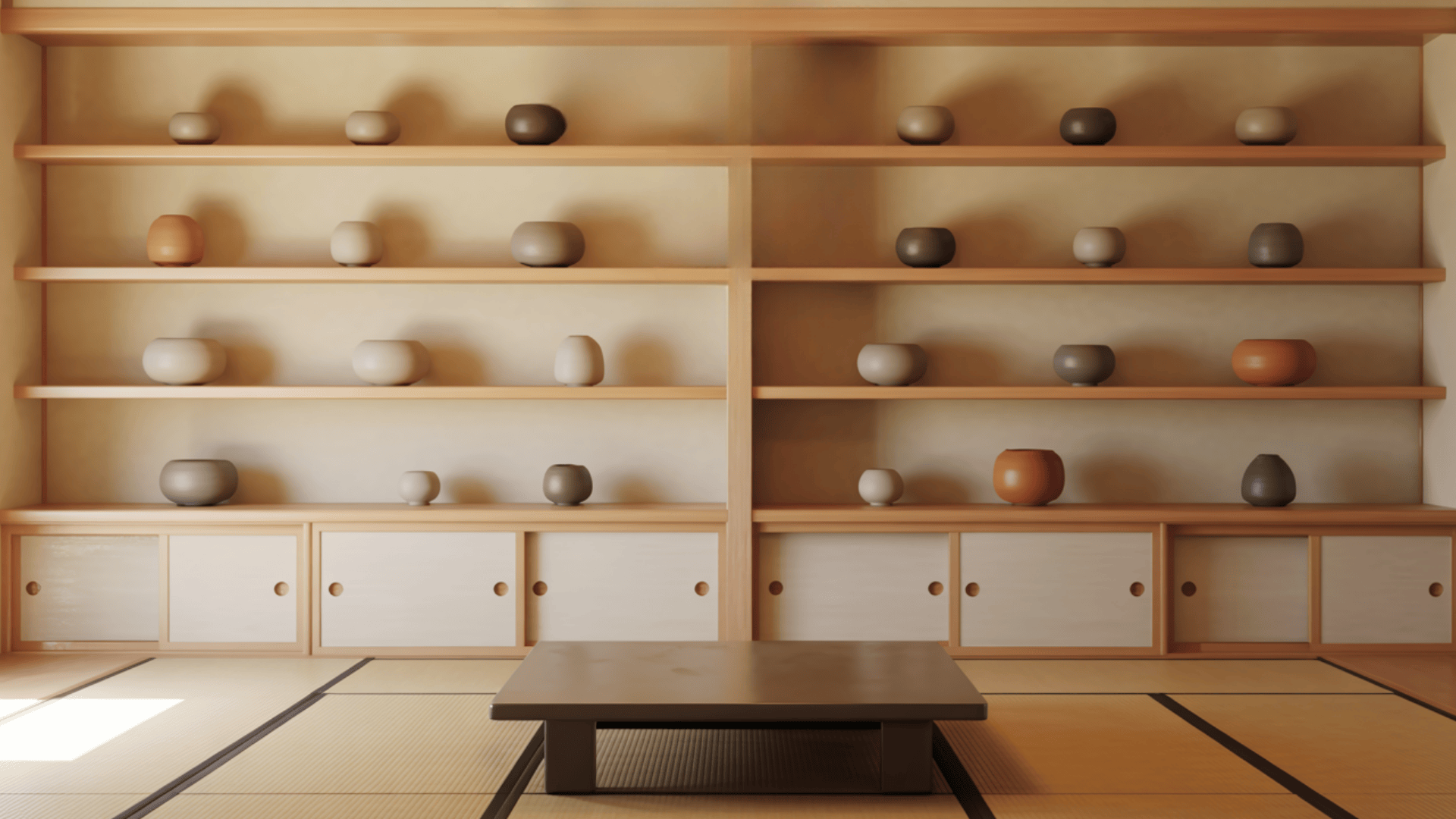
Arrange decorations along low tables, shelves, or platforms to keep the room grounded. Avoid tall arrangements that disrupt the flow of the space.
A few carefully chosen items make a stronger impact than a crowded display. This approach maintains the clean, horizontal lines common in Japanese interiors.
14. Indoor Plants for a Fresh, Zen Feel
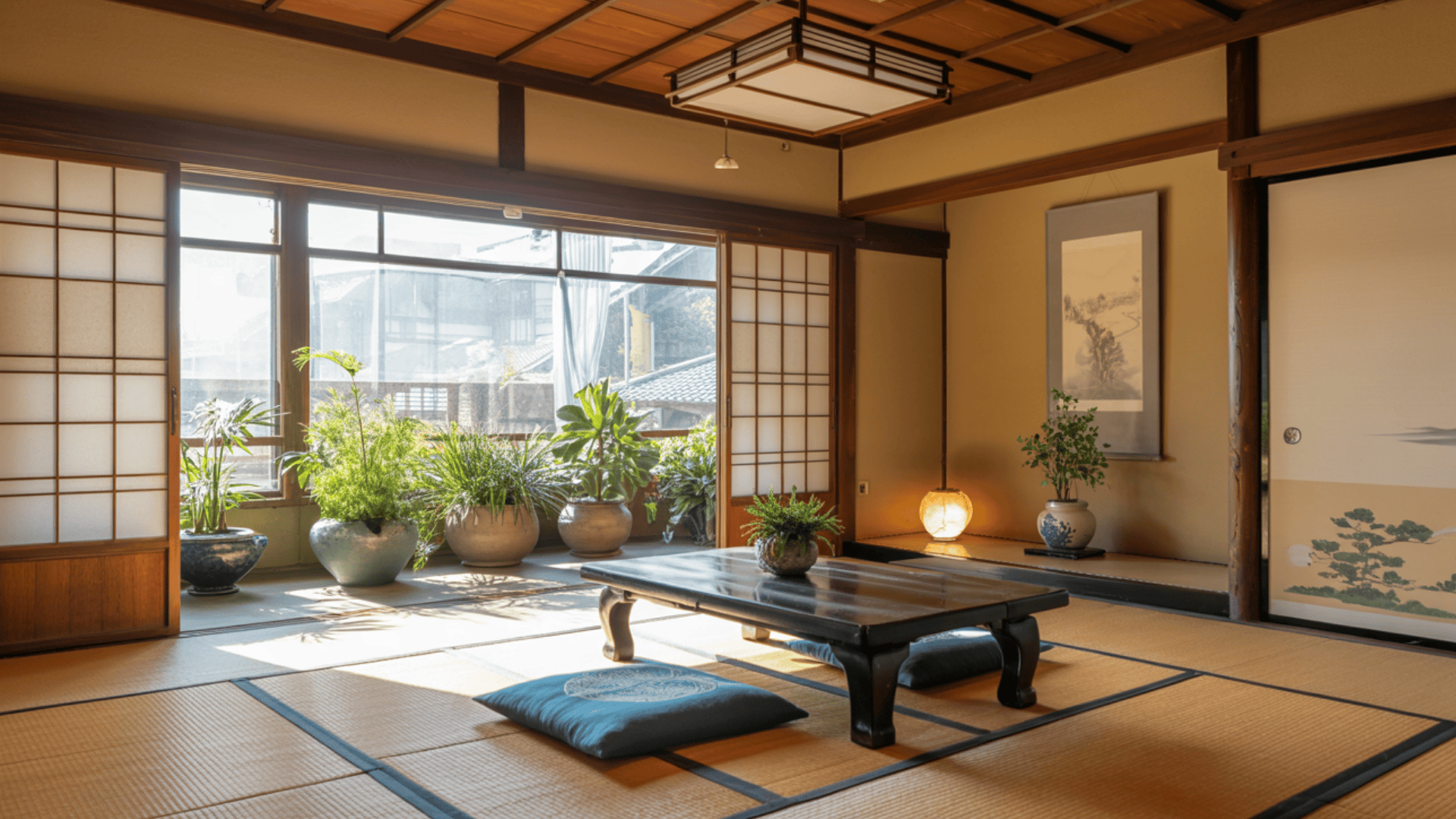
Plants like bamboo, orchids, and ferns bring life into the room without overwhelming it. Place them in simple pots and position them where they can get natural light.
A few well-placed plants can freshen the air and soften the room’s look. They help connect your living space to nature.
15. Stone or Pebbled Accents in Corners
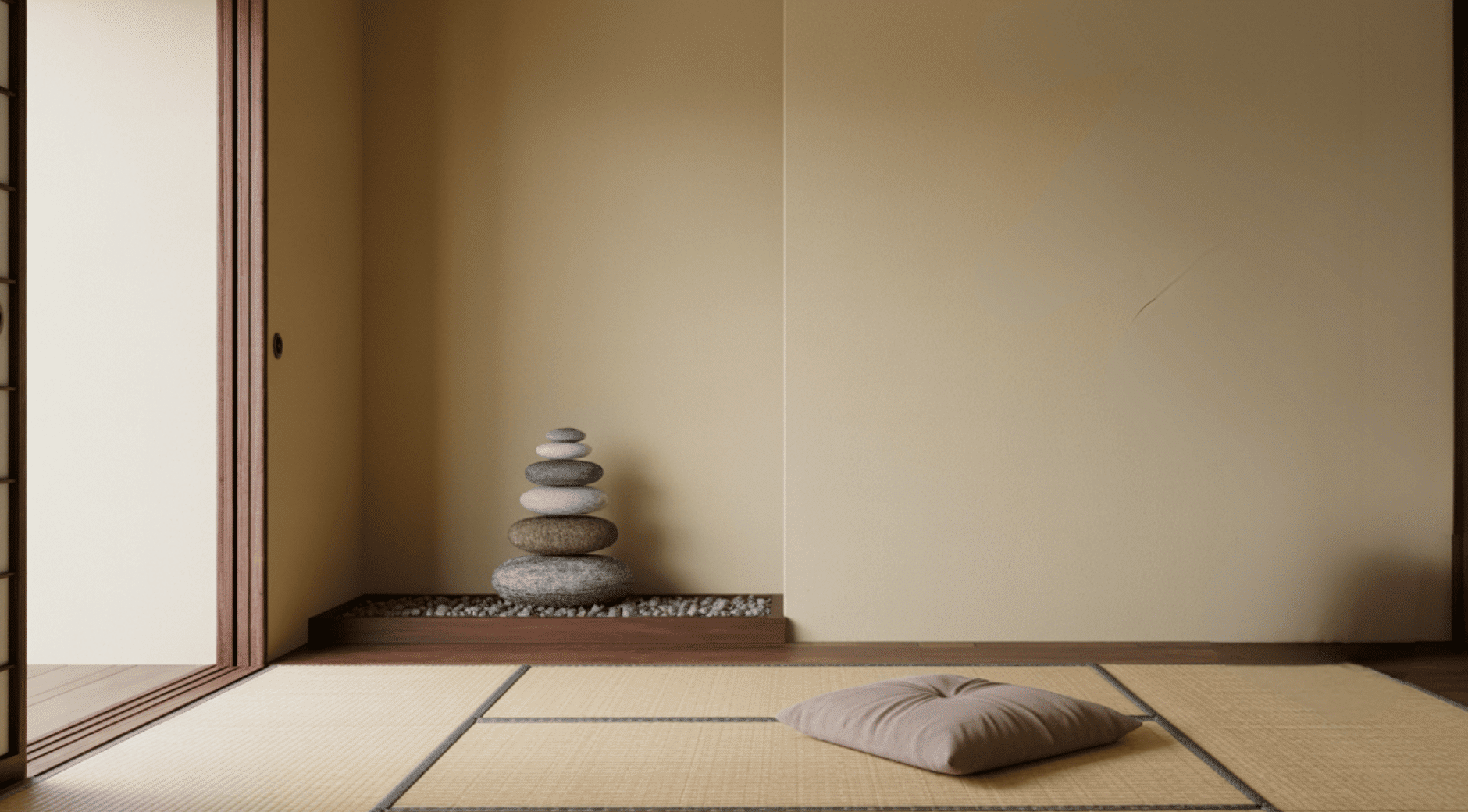
Small stone arrangements or pebble trays add a grounding element to the room. They can be placed in unused corners, near plants, or along entryways.
Natural textures like these make the space feel more peaceful and organic. This simple touch adds quiet beauty without cluttering the design.
16. Traditional Scroll Paintings (kakemono)
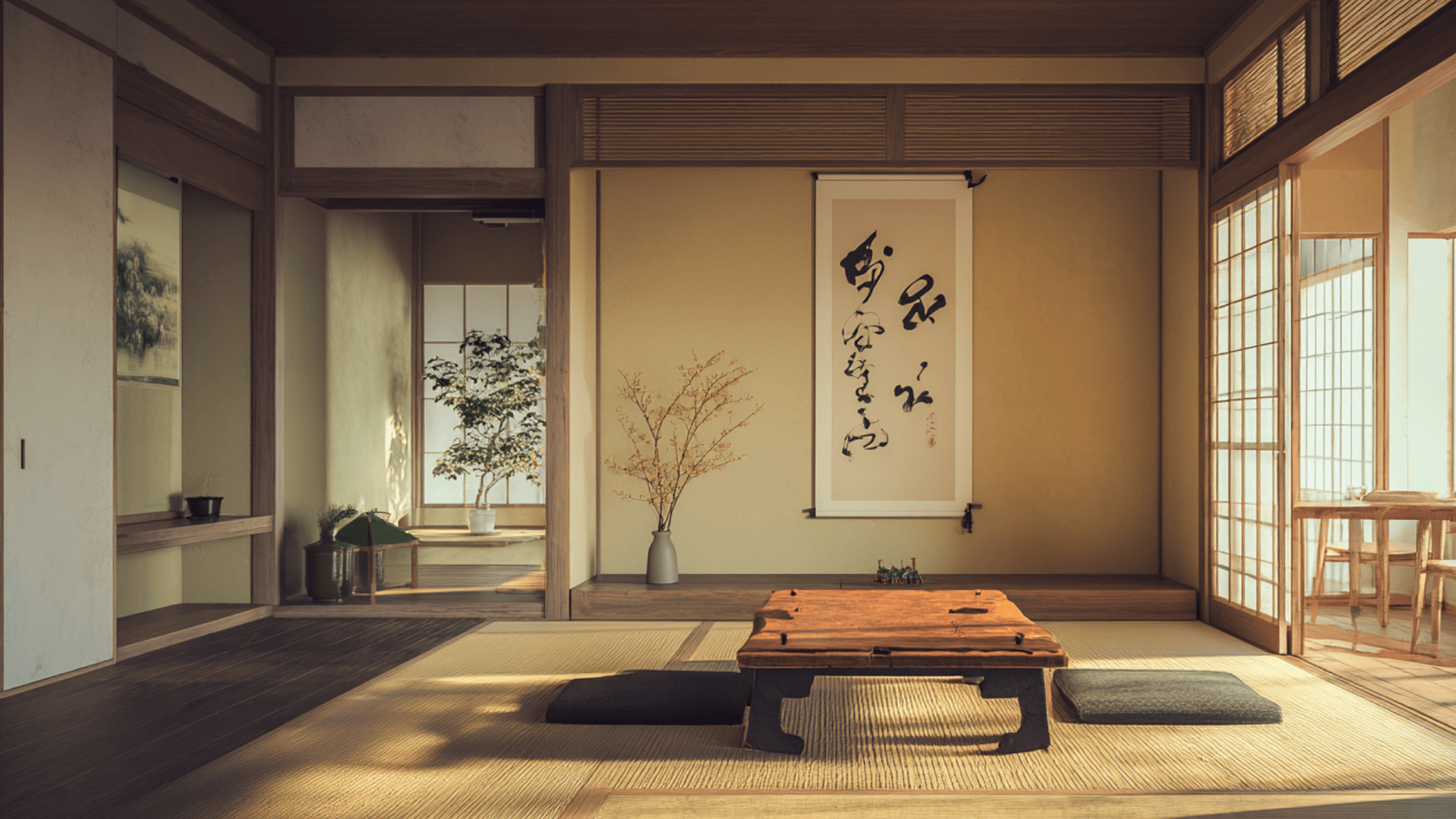
Scroll paintings featuring calligraphy or nature scenes add cultural depth. Hang one in a tokonoma or on a clean wall where it can be the focal point.
Choose soft colors and minimal patterns so they blend with the overall style. This single piece of art can give the room an authentic touch.
17. Raw Wood Finishes for Furniture
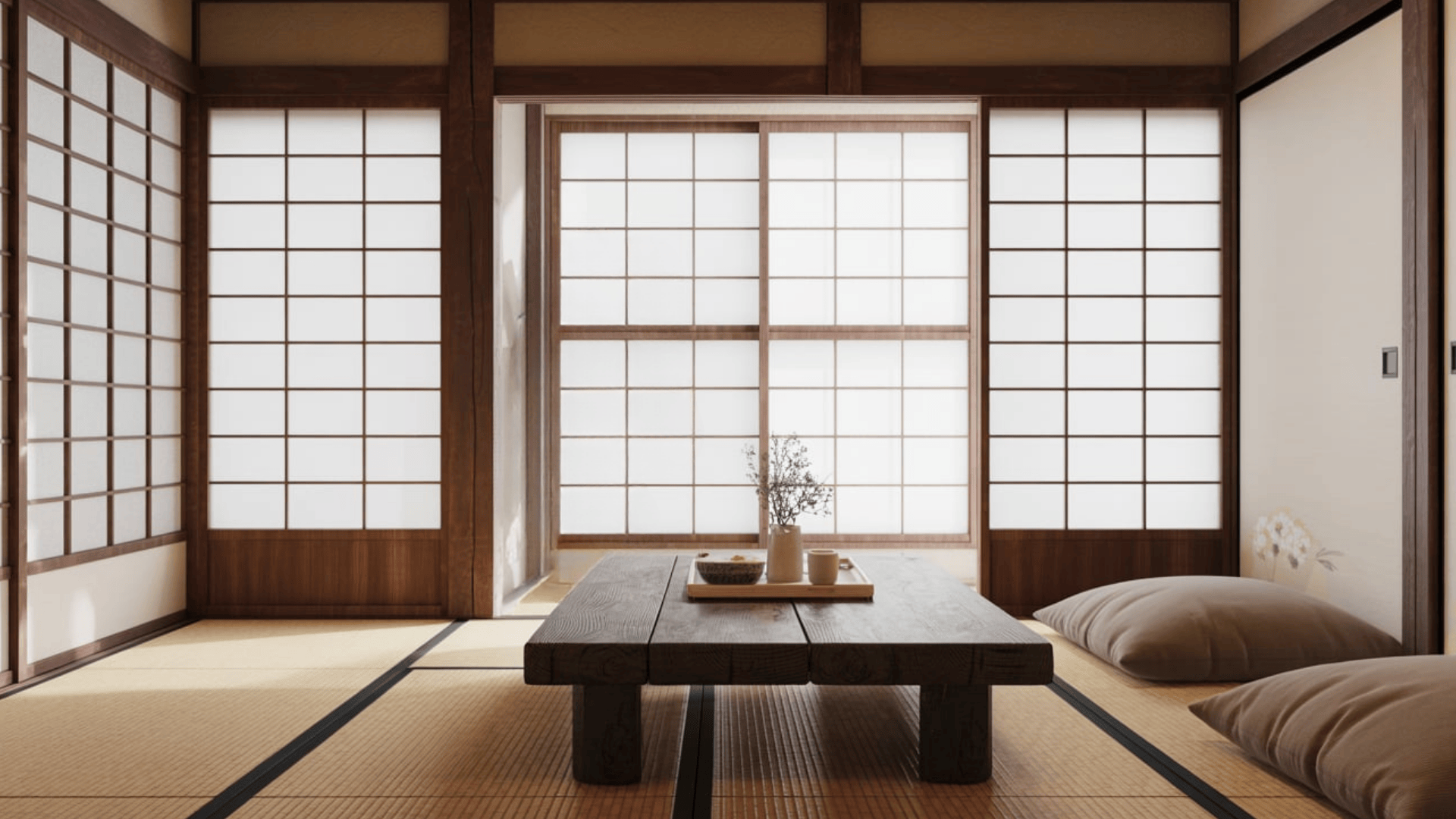
Raw or lightly finished wood keeps the grain and texture visible, adding warmth to the room. This works well for coffee tables, shelving, and seating frames.
Pair wood tones with neutral fabrics to keep the look balanced. The natural finish gives the space a classic, welcoming feel.
18. Tatami Platform for Seating and Sleeping
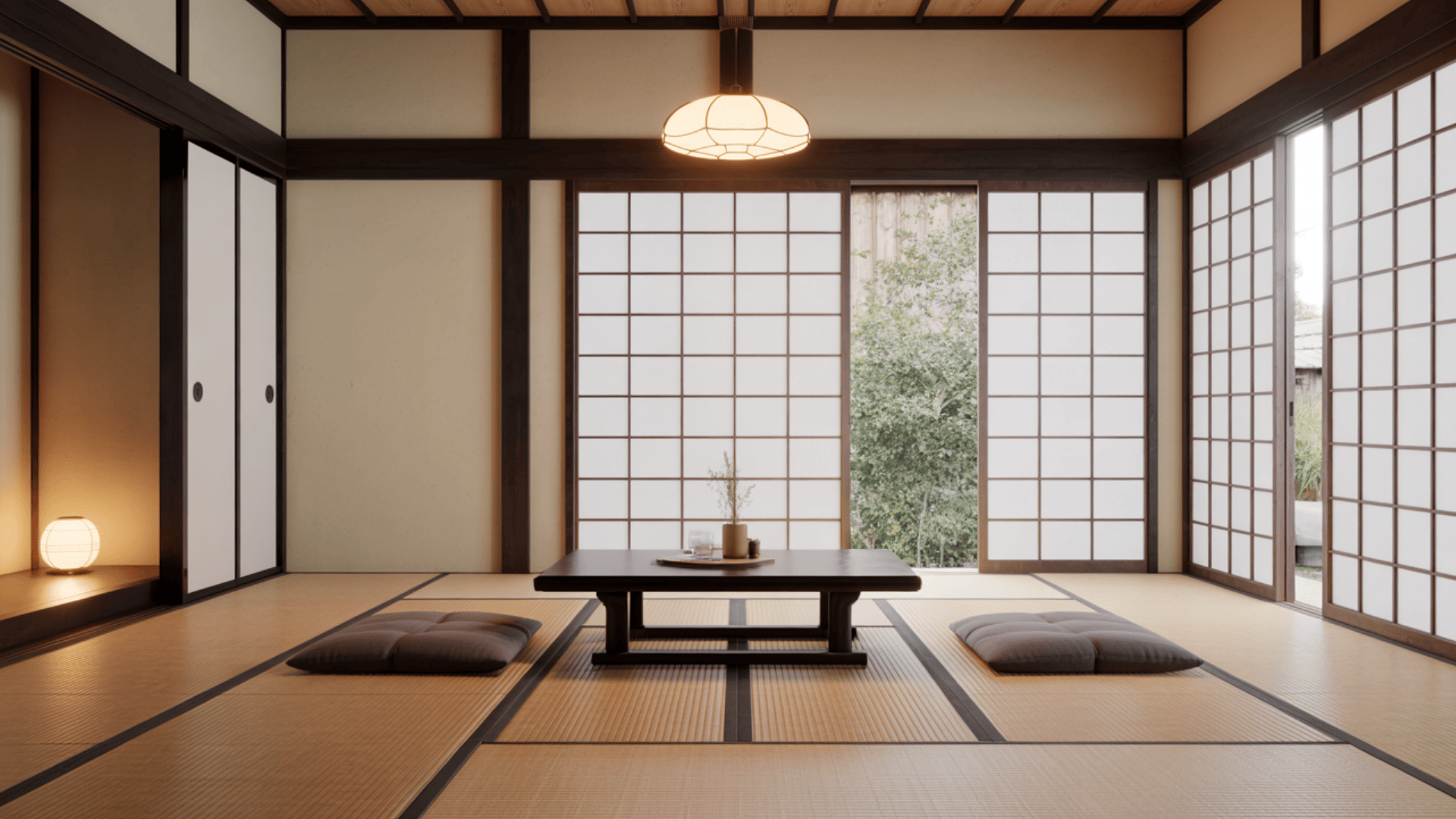
A tatami platform can serve as a lounge area during the day and a sleeping area at night. Use it with cushions for daytime comfort and bedding for overnight use.
This feature is perfect for small spaces where every inch counts. It combines traditional style with modern practicality.
19. Irori-Inspired Hearth for Warmth and Gathering
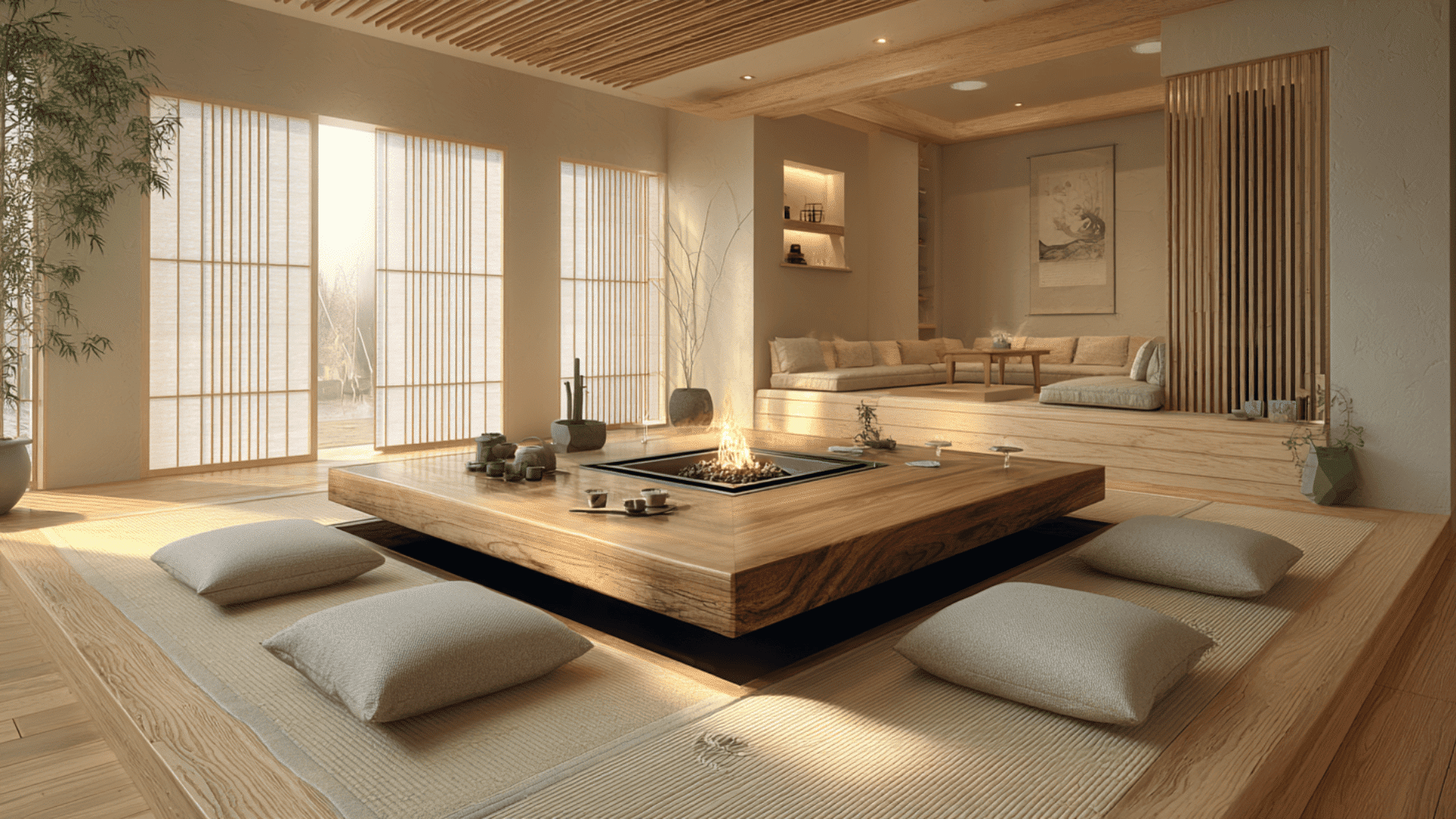
An irori is a traditional Japanese sunken hearth once used for heat and cooking. In a modern living room, you can echo this with a low central table that includes a small built-in fire or decorative hearth.
It creates warmth, a natural focal point, and a cozy place to gather without adding clutter.
20. Minimal Shelving for Books or Decor
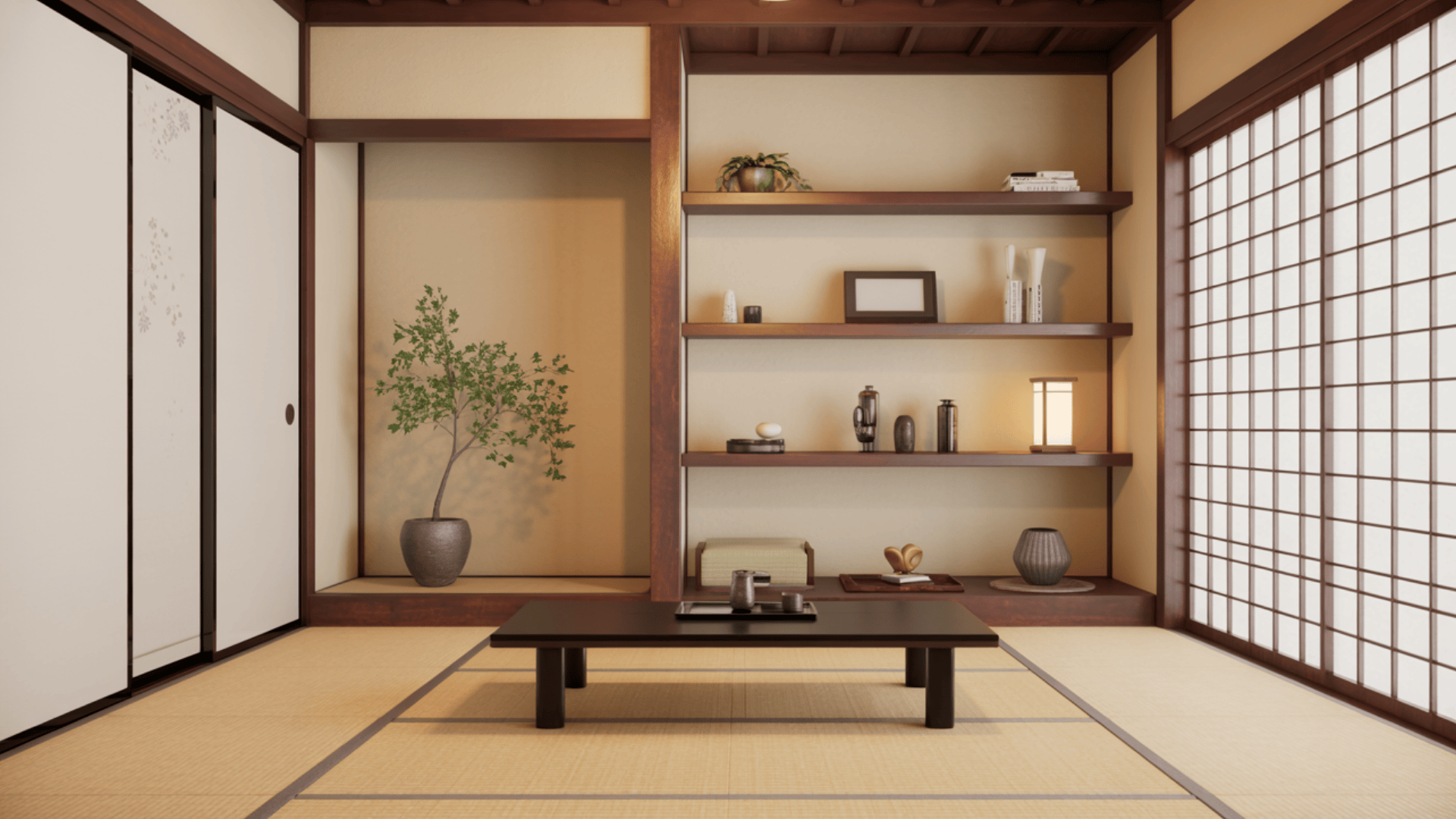
Minimal shelving offers storage without crowding the walls. Floating or recessed shelves work best to keep the design clean.
Limit the number of items displayed for a more open look. This helps the room feel organized and uncluttered.
21. Symmetry in Furniture Arrangement
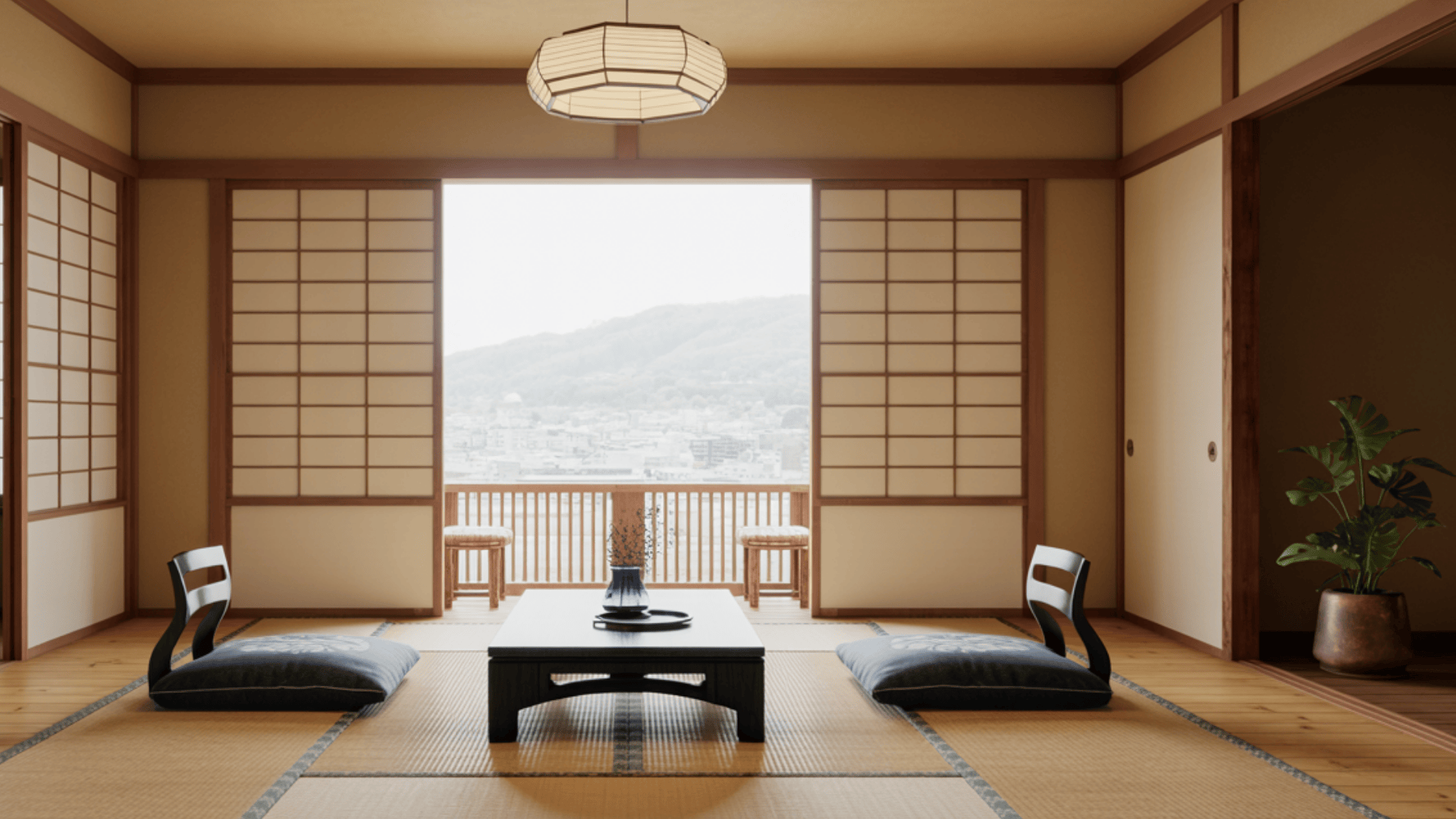
Arrange furniture and decor in balanced pairs for visual harmony. Matching chairs, lamps, or side tables can create a pleasing order.
Keep spacing even, so the layout feels intentional. This symmetry improves the peaceful, structured feel of the room.
22. Handmade Pottery as Decor
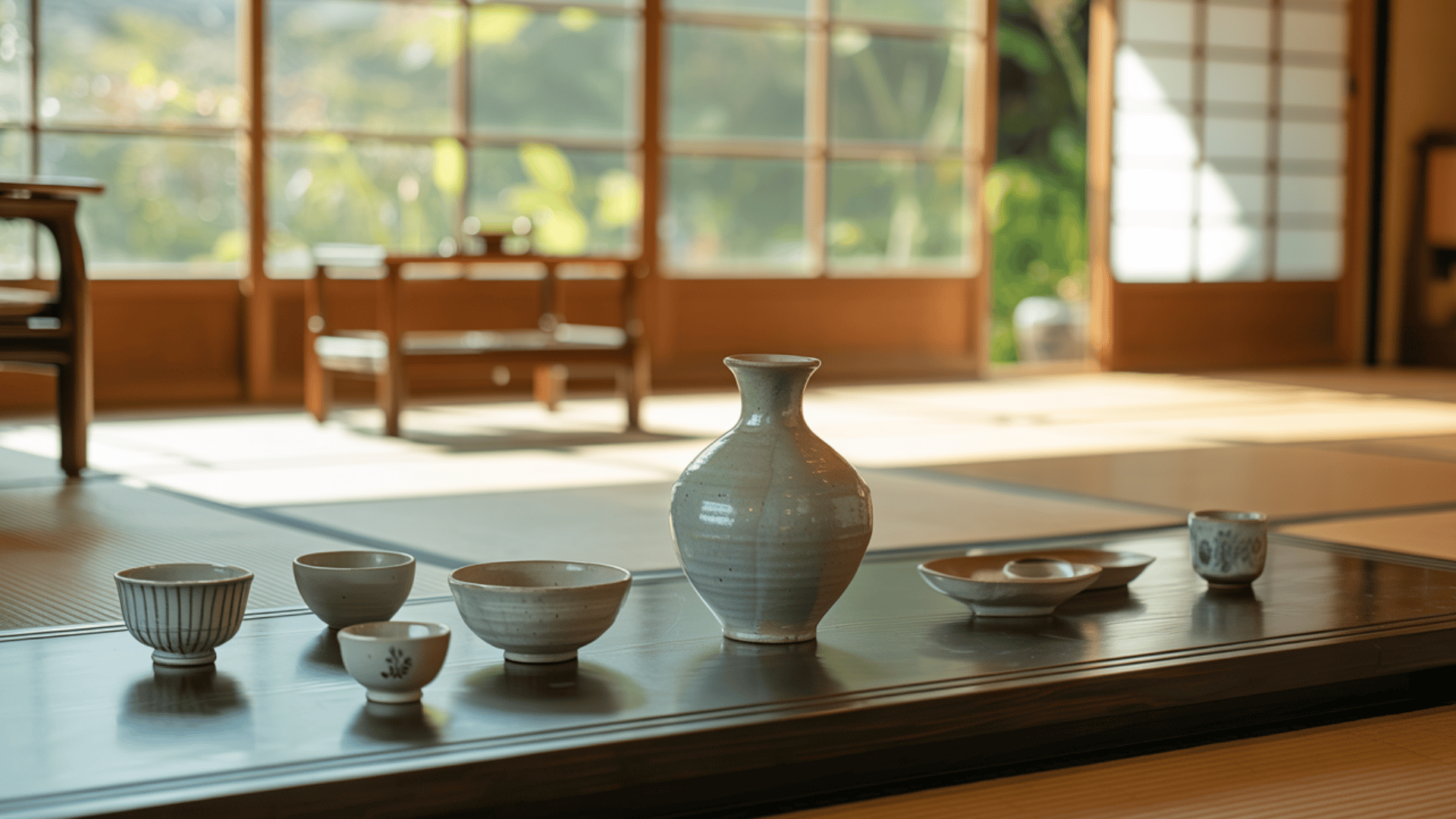
Handmade pottery adds texture and craftsmanship to the space. Display bowls, vases, or mugs on shelves or tables.
Stick to earthy colors and simple shapes to keep the style cohesive. Each piece brings a unique, natural touch to the room.
23. Natural Fabrics Like Linen or Cotton
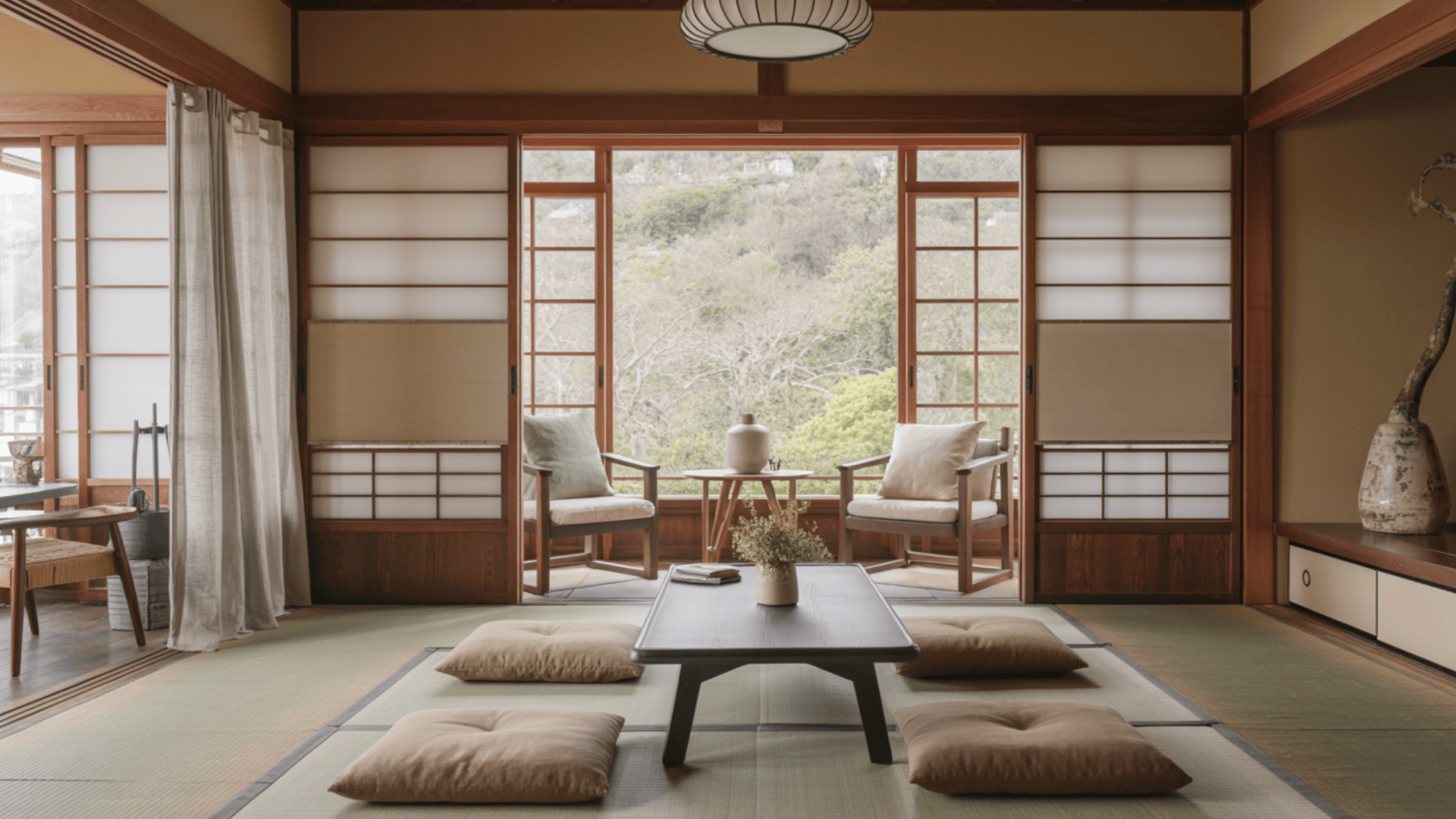
Natural fabrics feel soft, breathe well, and suit a relaxed atmosphere. Use them for curtains, cushions, or throws.
Choose light, solid colors, or subtle patterns for a simple look. These textiles keep the room comfortable and easy to maintain.
24. Futon that Can Double as A Bed
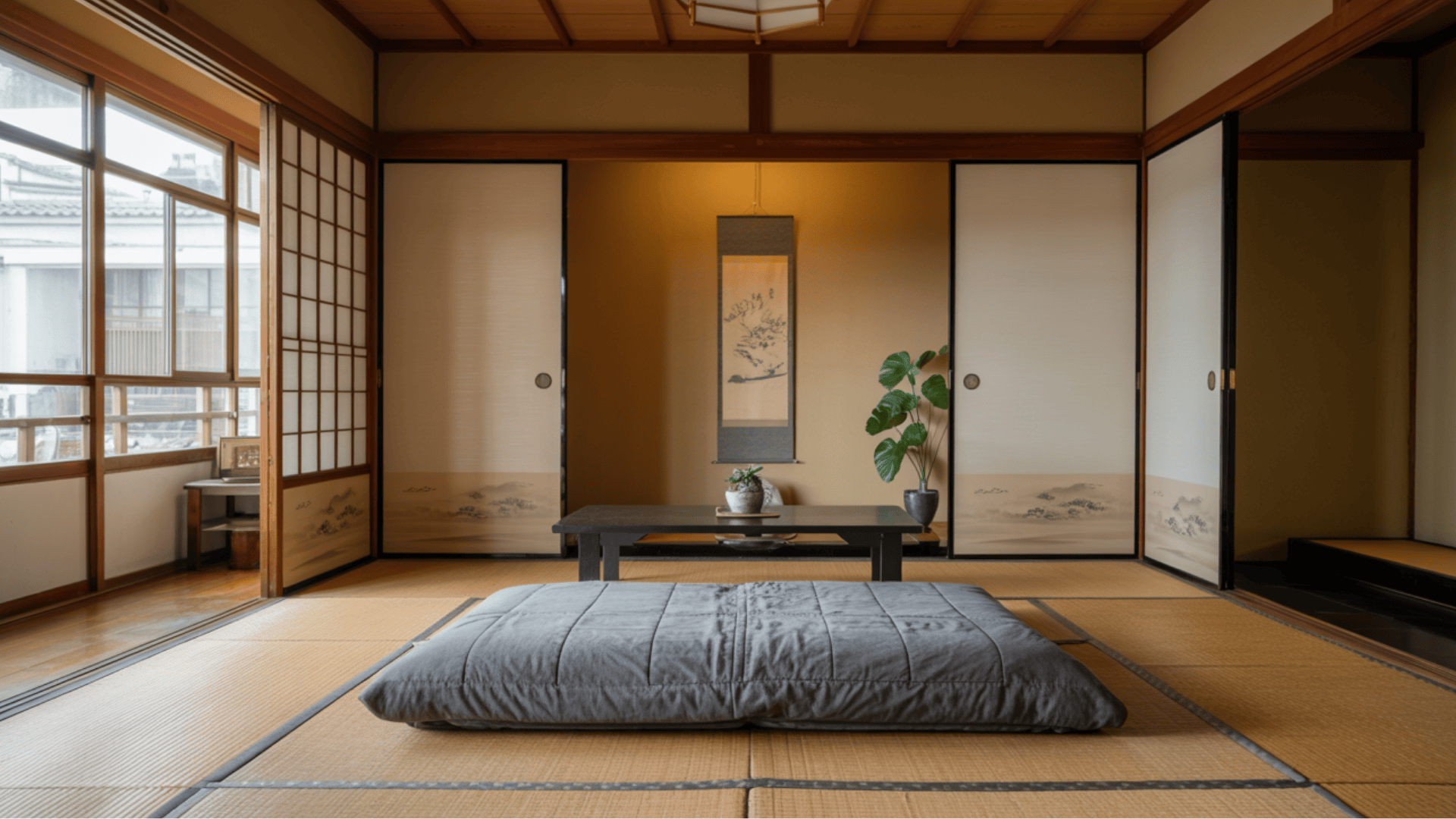
A foldable futon is a versatile piece for seating and sleeping. Use it in living rooms that double as guest spaces.
Choose a cover that matches your decor for a perfect look. It saves space while offering comfort for both day and night use.
25. Small Tea Ceremony Corner
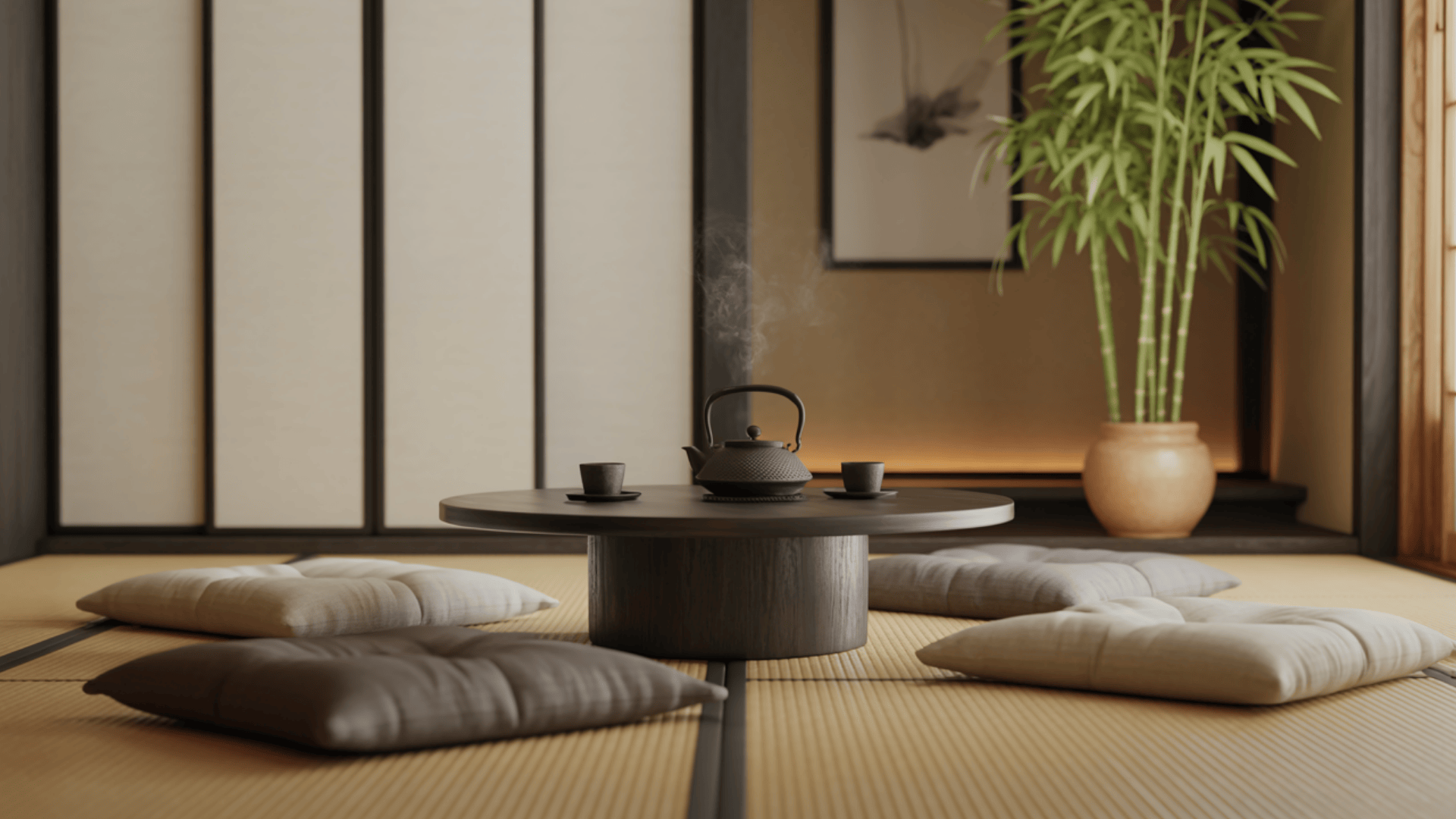
Set up a low table with a tea set and floor cushions in a quiet spot. Keep the area simple with minimal decoration.
This can be a peaceful place to relax and unwind. It also adds a meaningful cultural element to your living room.
26. Woven Straw Baskets for Storage
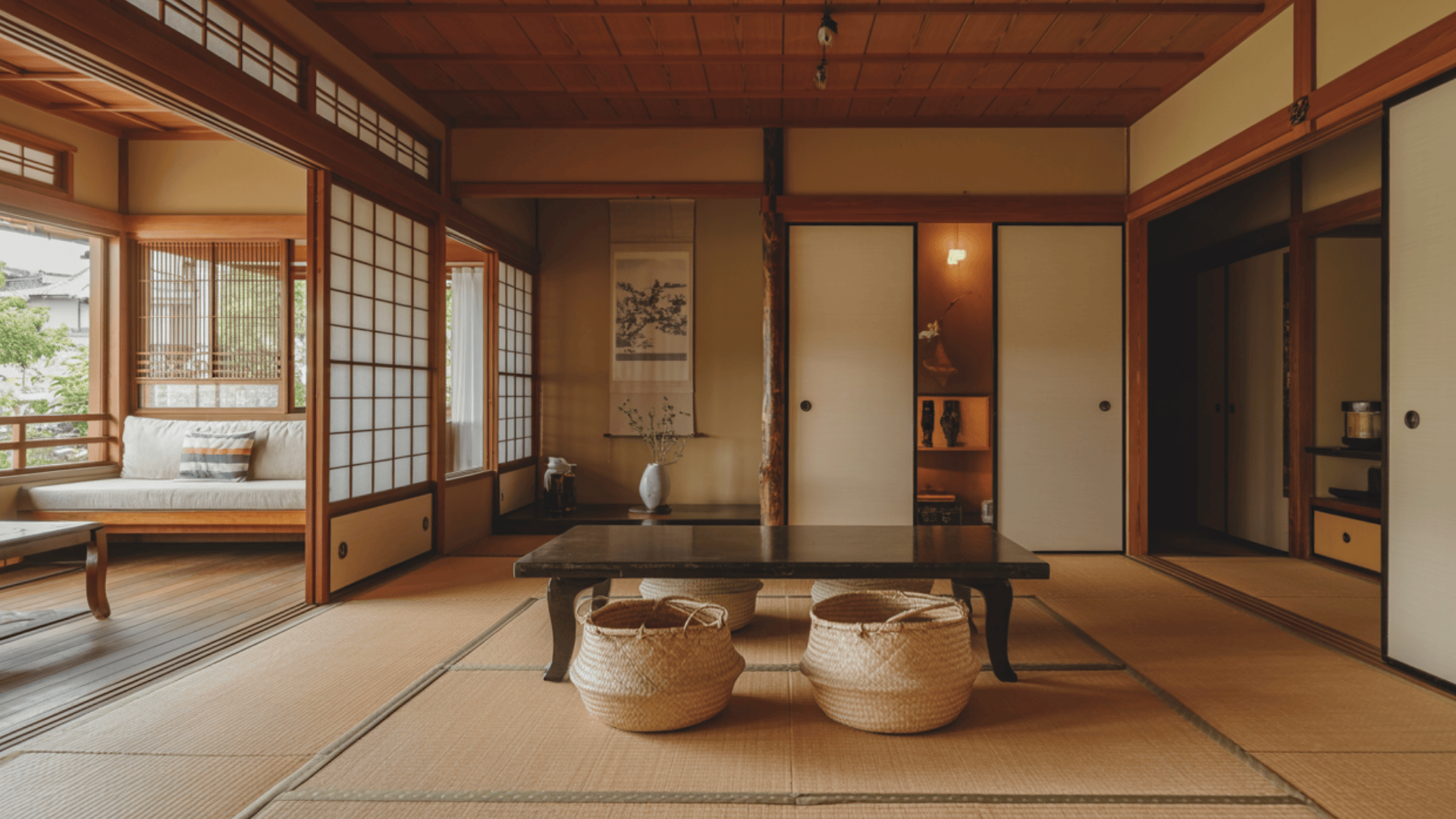
Straw baskets provide a natural way to store blankets, magazines, or small items. Place items under tables or along walls to save space.
Their texture pairs well with wood and fabric in Japanese-style rooms. They help keep the room neat without looking plain.
27. Electronics Hidden when Not in Use
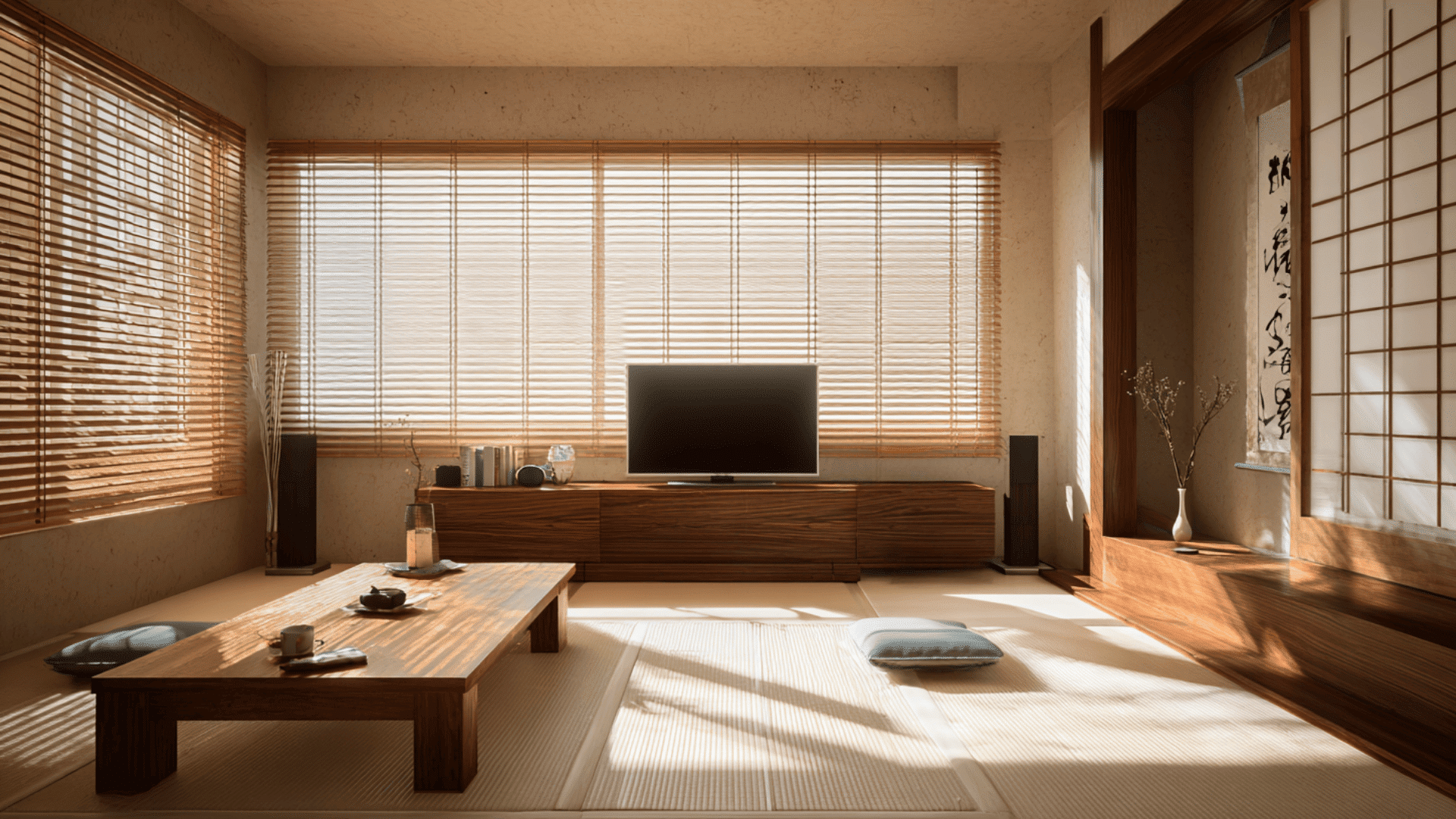
Hide TVs, speakers, and cords inside cabinets or behind sliding panels. This prevents modern tech from dominating the space.
Concealing electronics helps maintain the peaceful, natural feel of the room. The focus stays on the design instead of the devices.
28. Single Statement Vase with Fresh Flowers
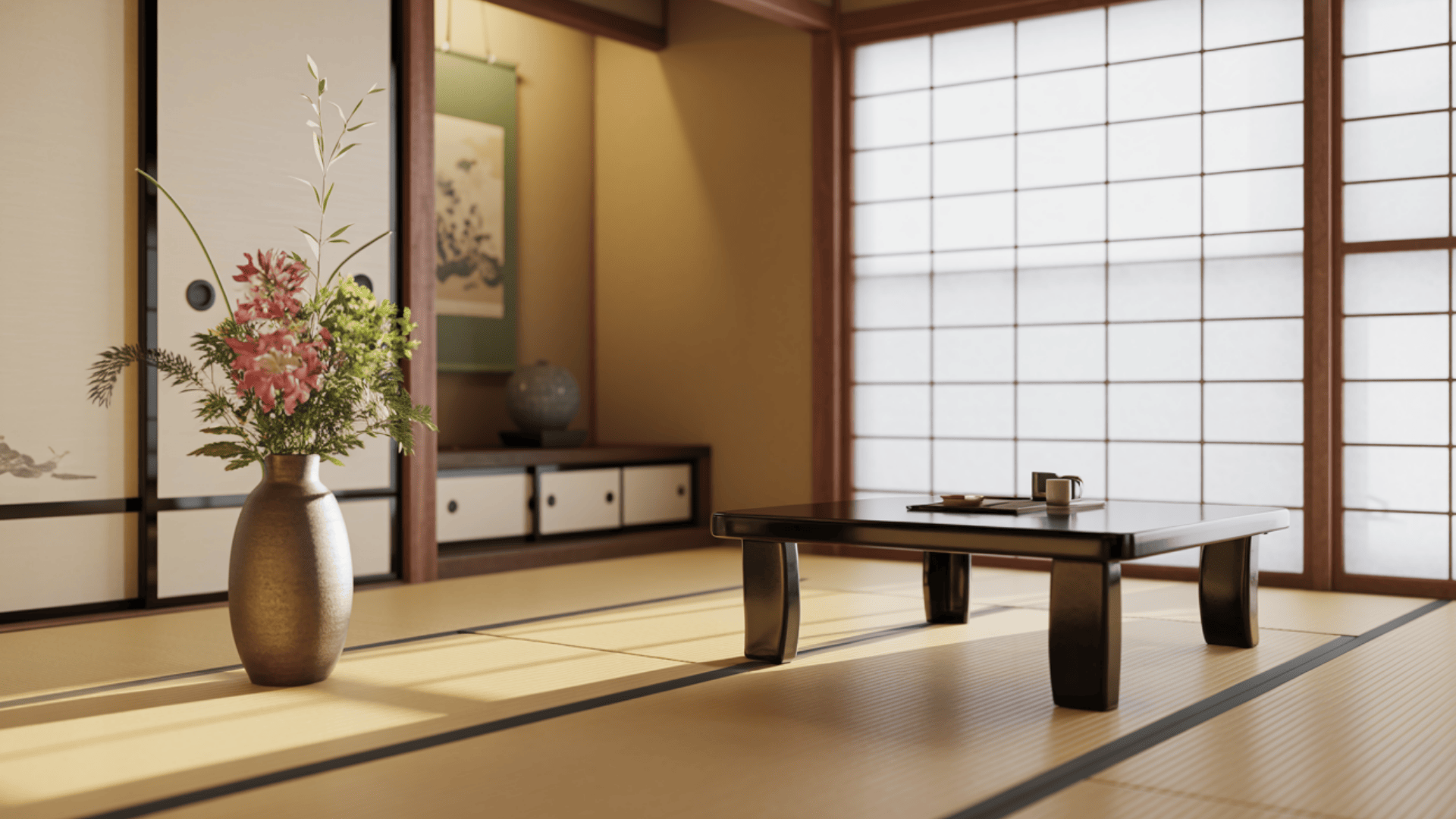
A tall, simple vase with seasonal flowers can serve as a perfect centerpiece. Keep the arrangement minimal so it matches the clean style. Switch flowers with the seasons to keep the room fresh and bright.
29. Floor-Level Lighting Instead of Overhead
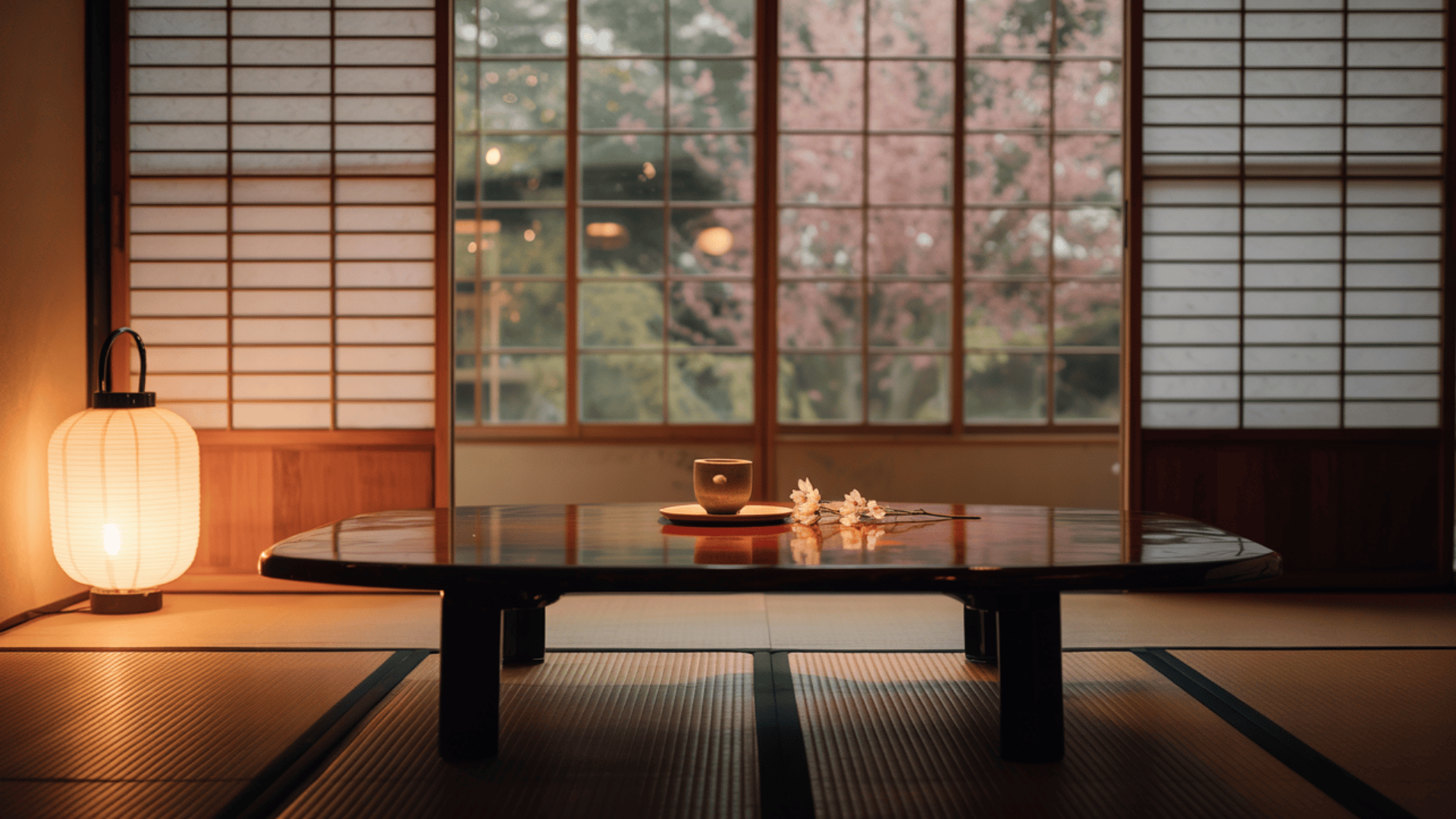
Lanterns, low table lamps, and floor lamps create a softer mood. Place them near seating areas or along pathways.
Avoid harsh ceiling lights that can feel too bright. This type of lighting makes the space feel cozy and inviting.
30. Folding Bamboo Room Divider
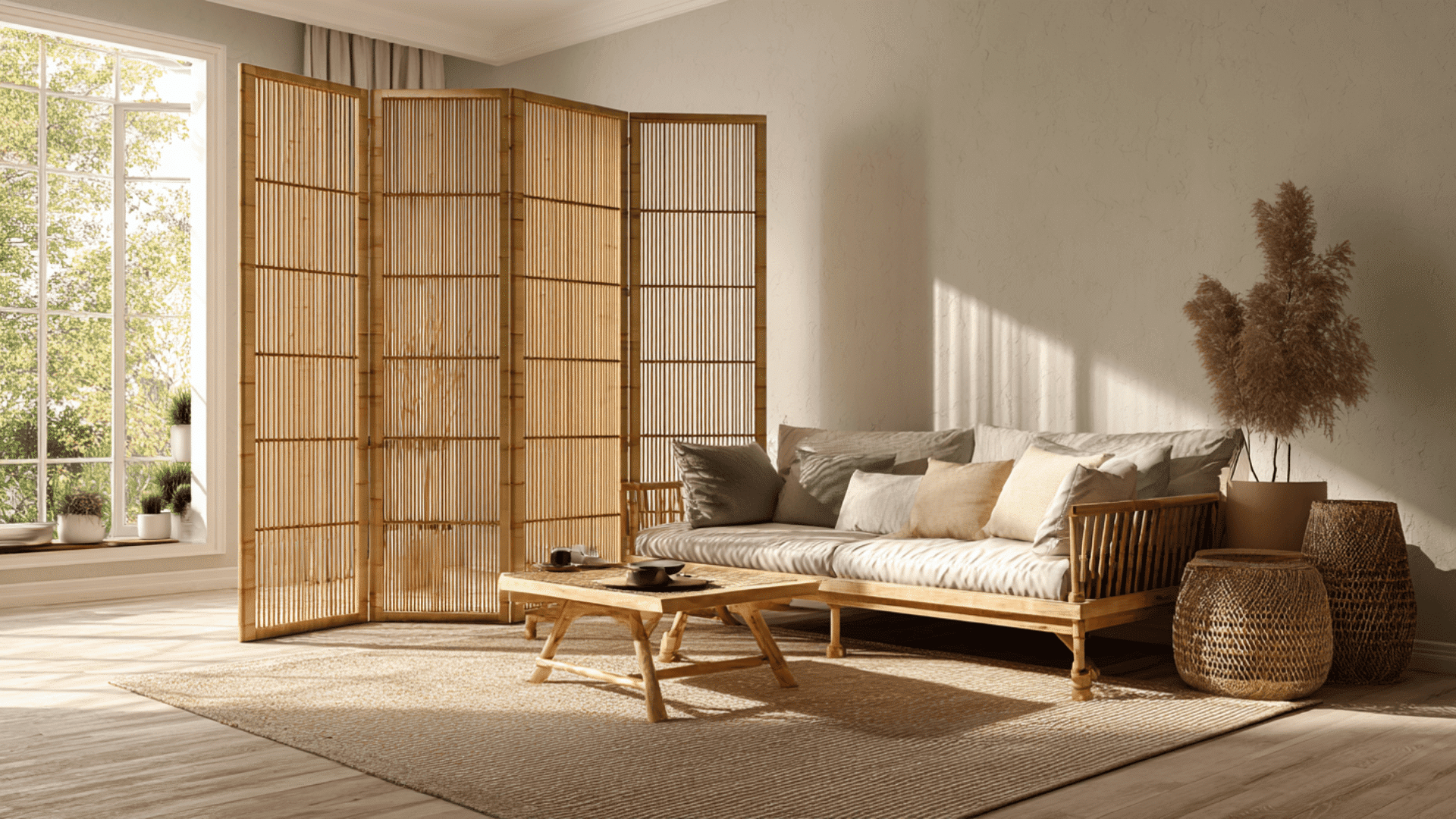
A bamboo divider can separate areas while still allowing light through. Fold it away when not needed to save space.
The natural texture fits perfectly with other organic elements. It’s a flexible and stylish way to define spaces.
31. Noren Curtains Between Spaces
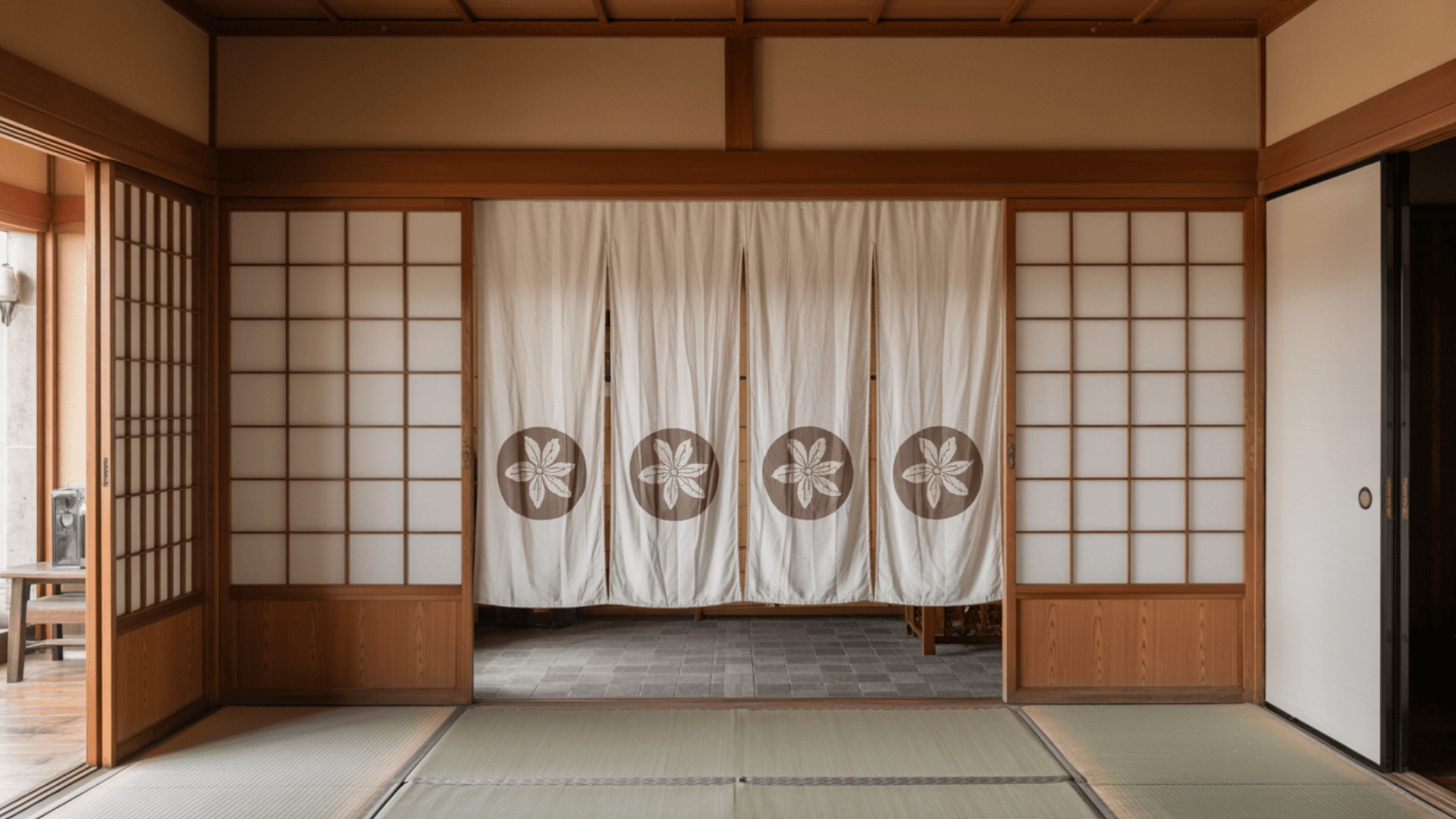
Noren curtains are short panels that hang in doorways. They help define areas while allowing airflow and light to pass.
Choose plain fabric or simple patterns that match the room. They add a subtle traditional touch.
32. Zen Rock Garden
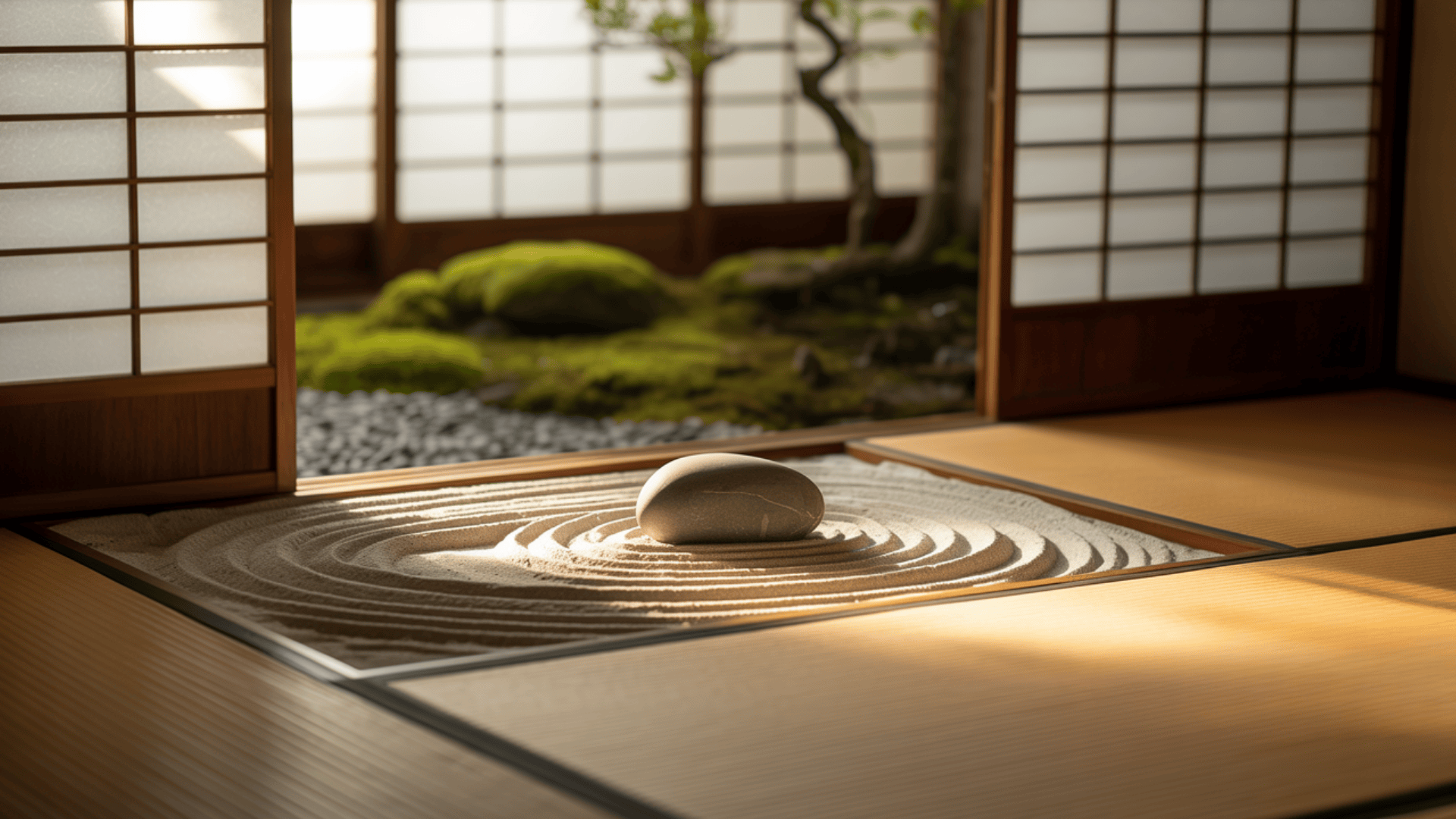
A small tray with sand and smooth stones can serve as a quiet focal point. Rake patterns into the sand for a meditative activity.
Add a small plant or ornament for interest. This feature brings a peaceful, mindful element into the space.
33. Engawa-Inspired Transition Space
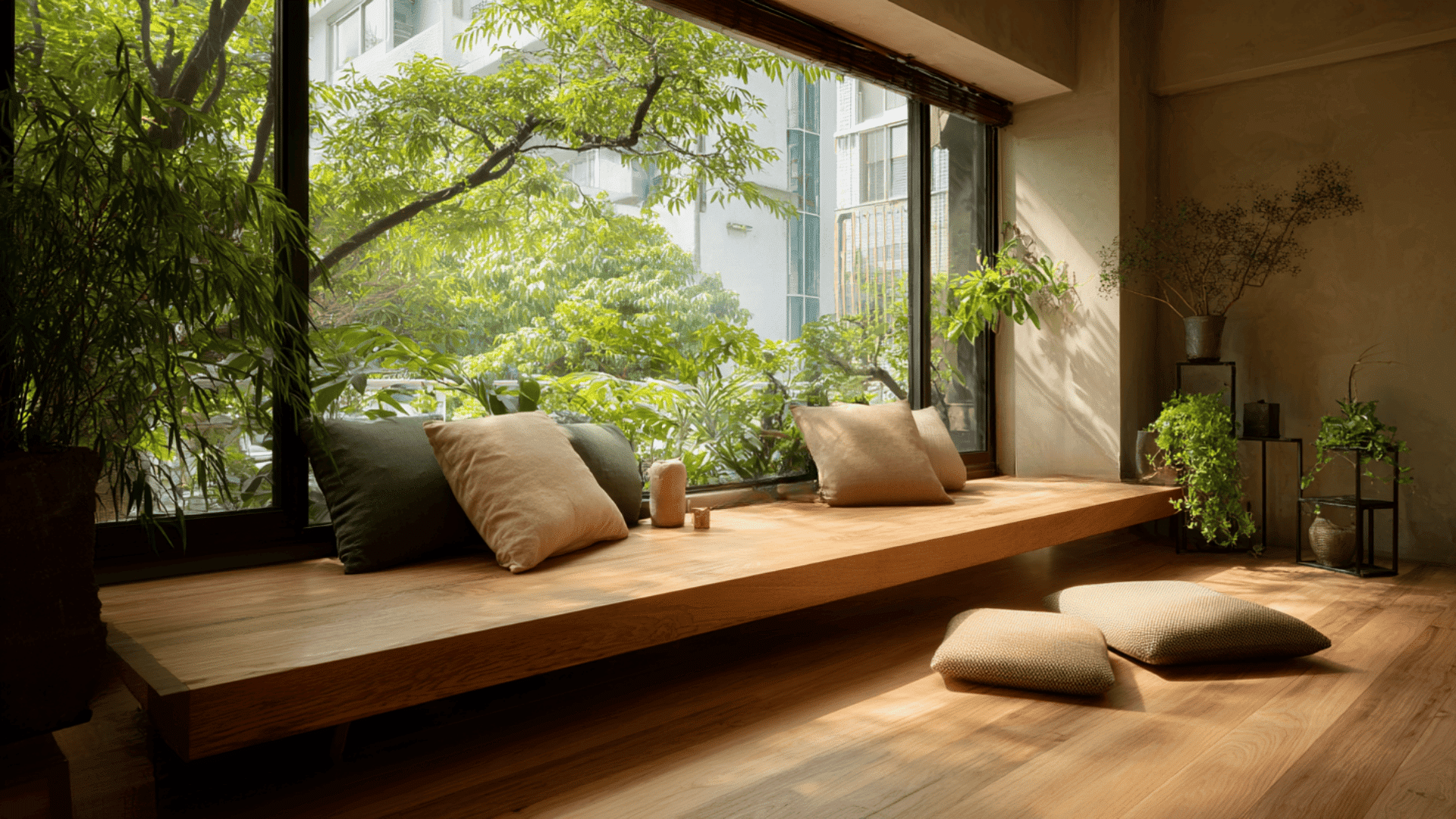
An engawa is a narrow wooden veranda that links indoor rooms to the garden. You can bring this idea inside with a small raised wooden platform or a bench by a window or wall.
It creates a quiet sitting spot, offers natural light, and reminds you of the connection between indoors and outdoors.
34. Small Water Feature
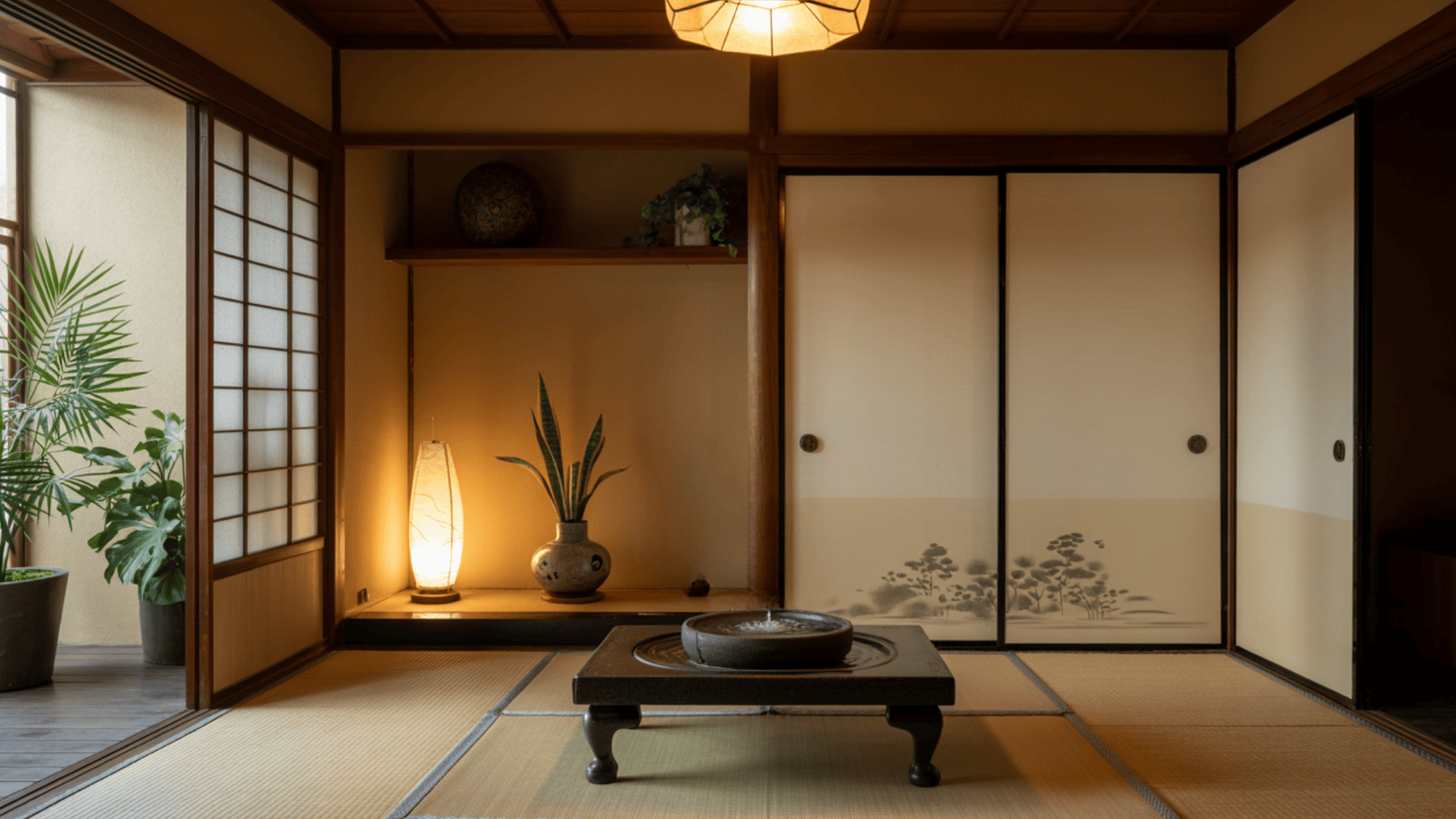
A tabletop fountain or water bowl creates soothing background sound. Place it in a seating area or near it to enjoy its effect.
The sound of running water helps the room feel more relaxing. It also adds a subtle natural element.
35. Simple Wall Art
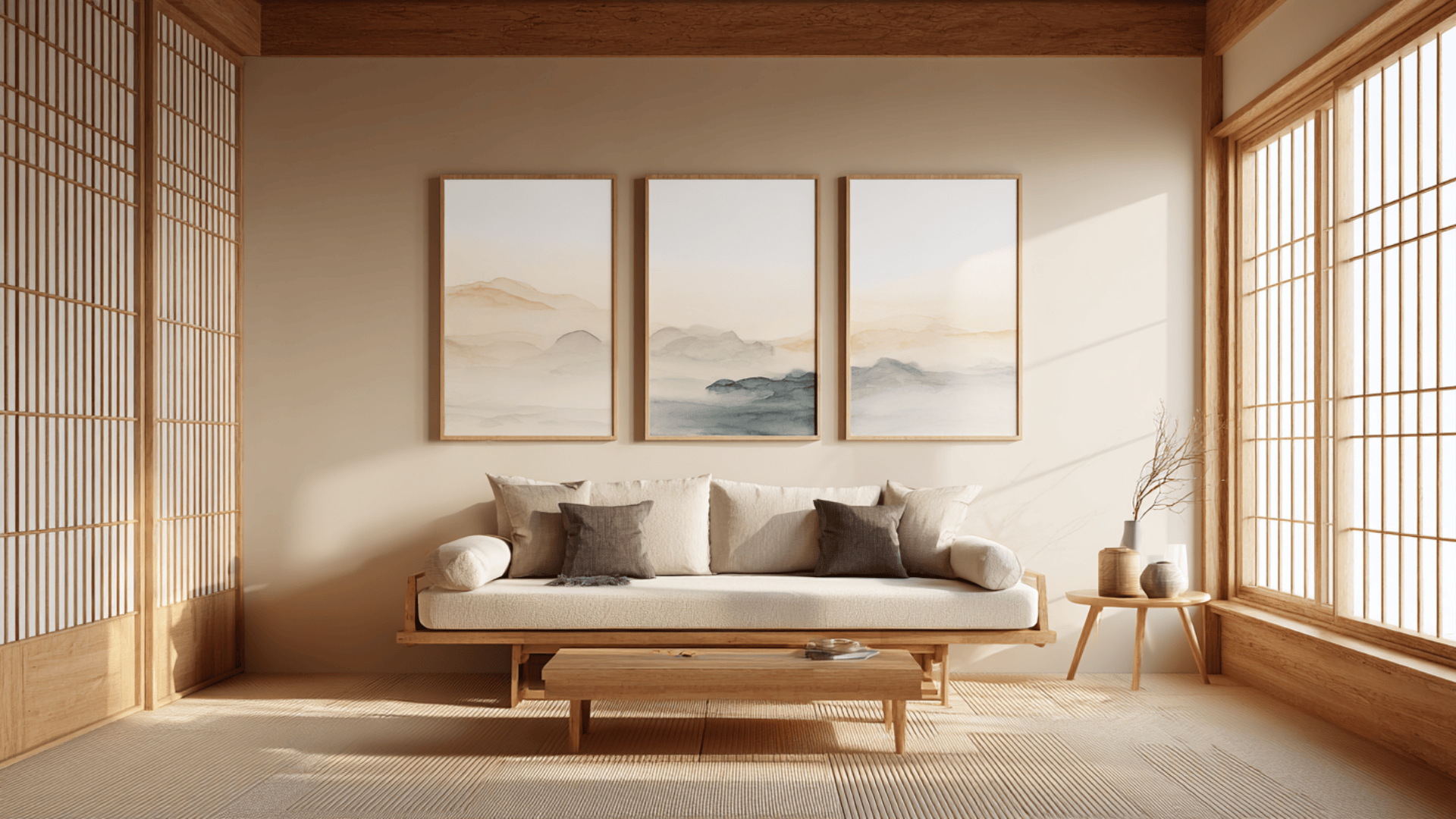
Wall art keeps the walls looking clean and uncluttered. Choose pieces that reflect nature or peaceful abstract designs. Hang them at eye level for the best effect.
This keeps the style simple and harmonious. You can also group a few related pieces together for a gallery feel without overwhelming the space.
36. Natural Scent Diffusers Like Hinoki Wood
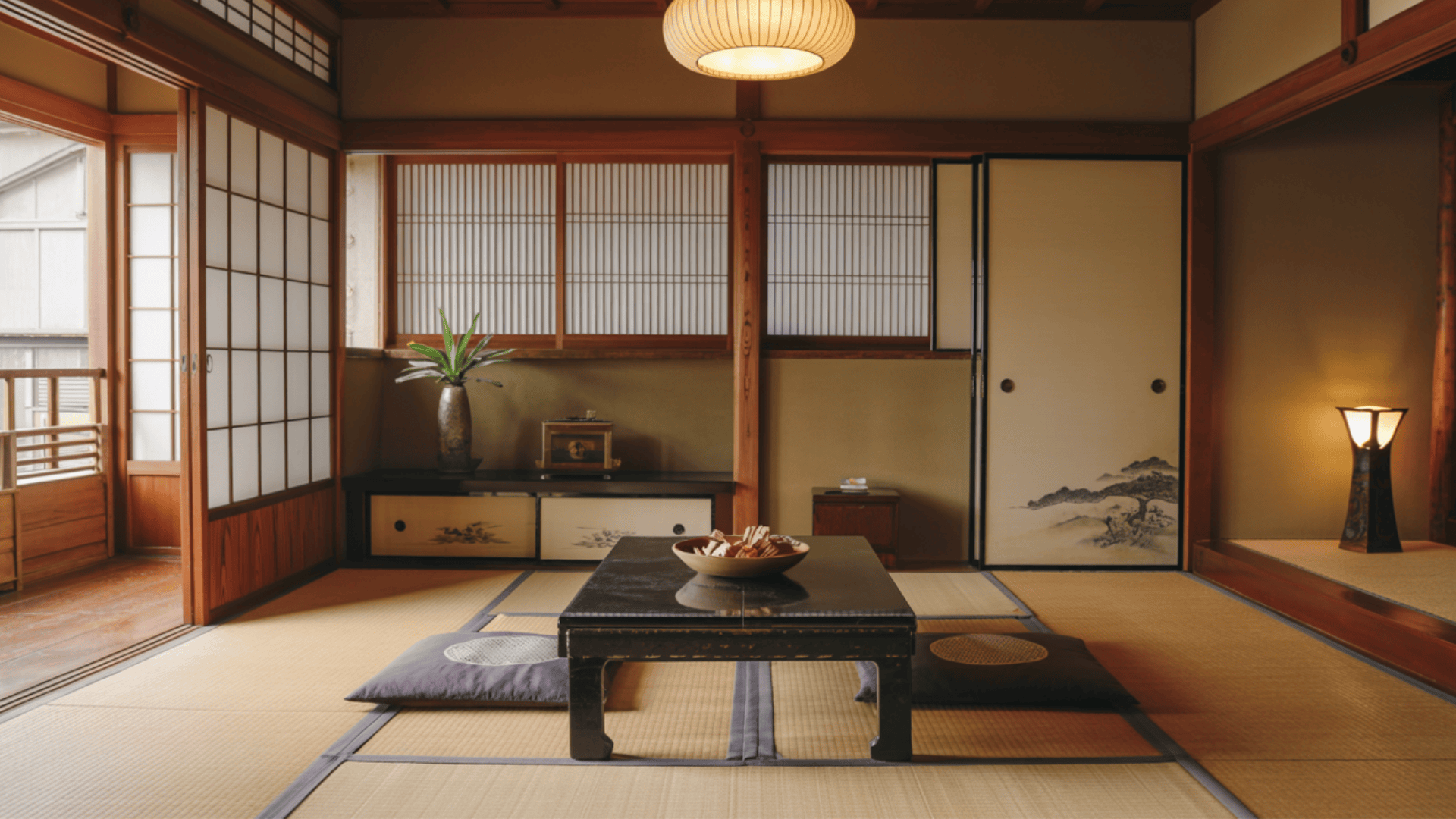
Hinoki wood releases a light, fresh scent that lasts for months. Place small pieces in bowls or on shelves.
It also adds a warm, natural look to the decor. This scent can make the space more pleasant without overpowering it.
37. Minimal Furniture Legs
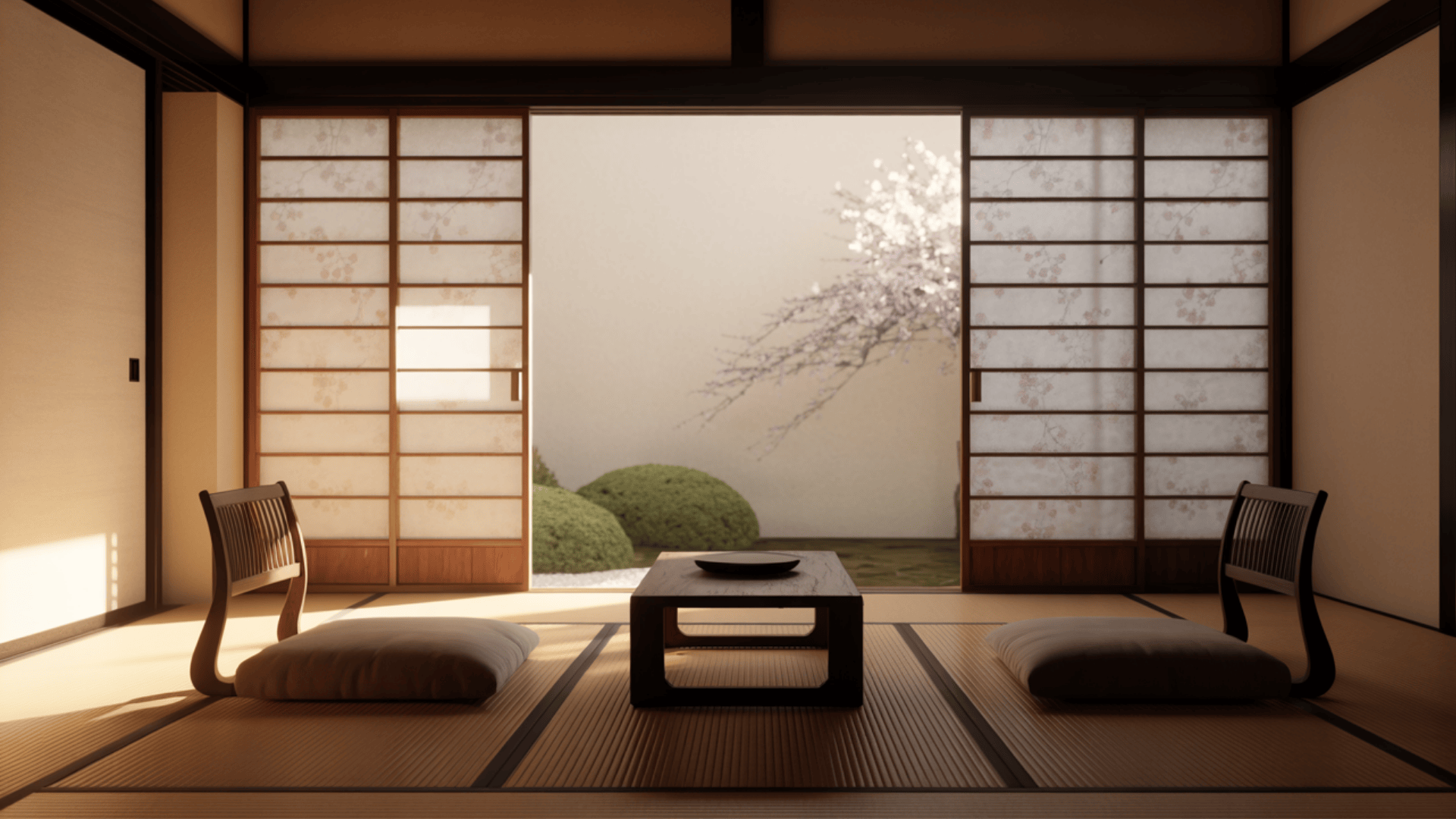
Choose furniture with low or hidden legs to keep the focus on clean lines. Skirted pieces or floor cushions also work well.
This keeps the look grounded and open. The result is a room that feels peaceful and uncluttered.
38. Indoor-Outdoor Connection with Large Windows
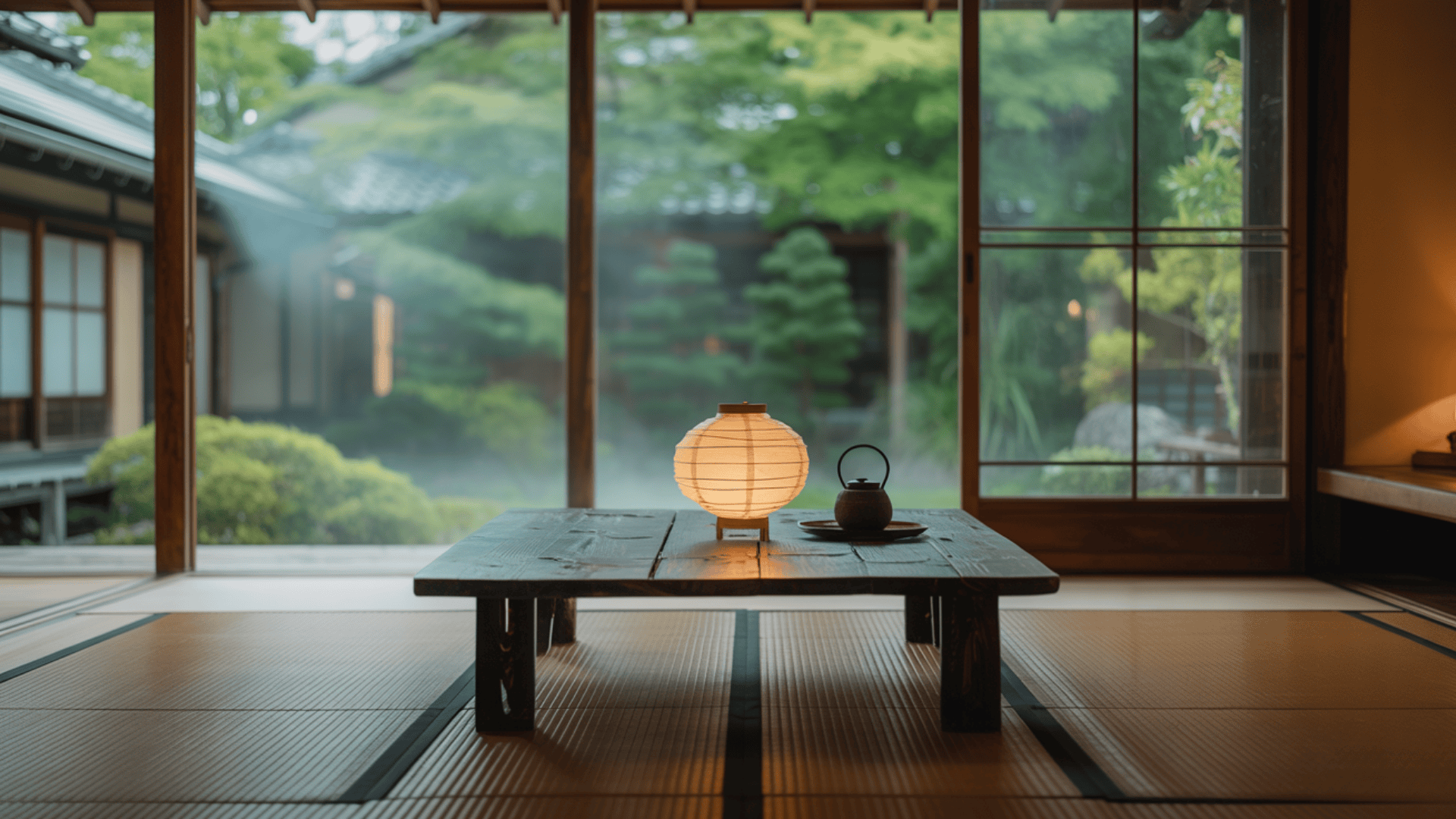
Wide windows bring in natural light and views. Keep coverings light so they don’t block the scenery. Connecting the indoors with the outdoors makes the space feel bigger.
It also strengthens the link to nature. Adding sliding glass panels or folding doors can make this connection even stronger, allowing fresh air and garden scents to flow inside.
39. Layered Rugs for Warmth and Texture
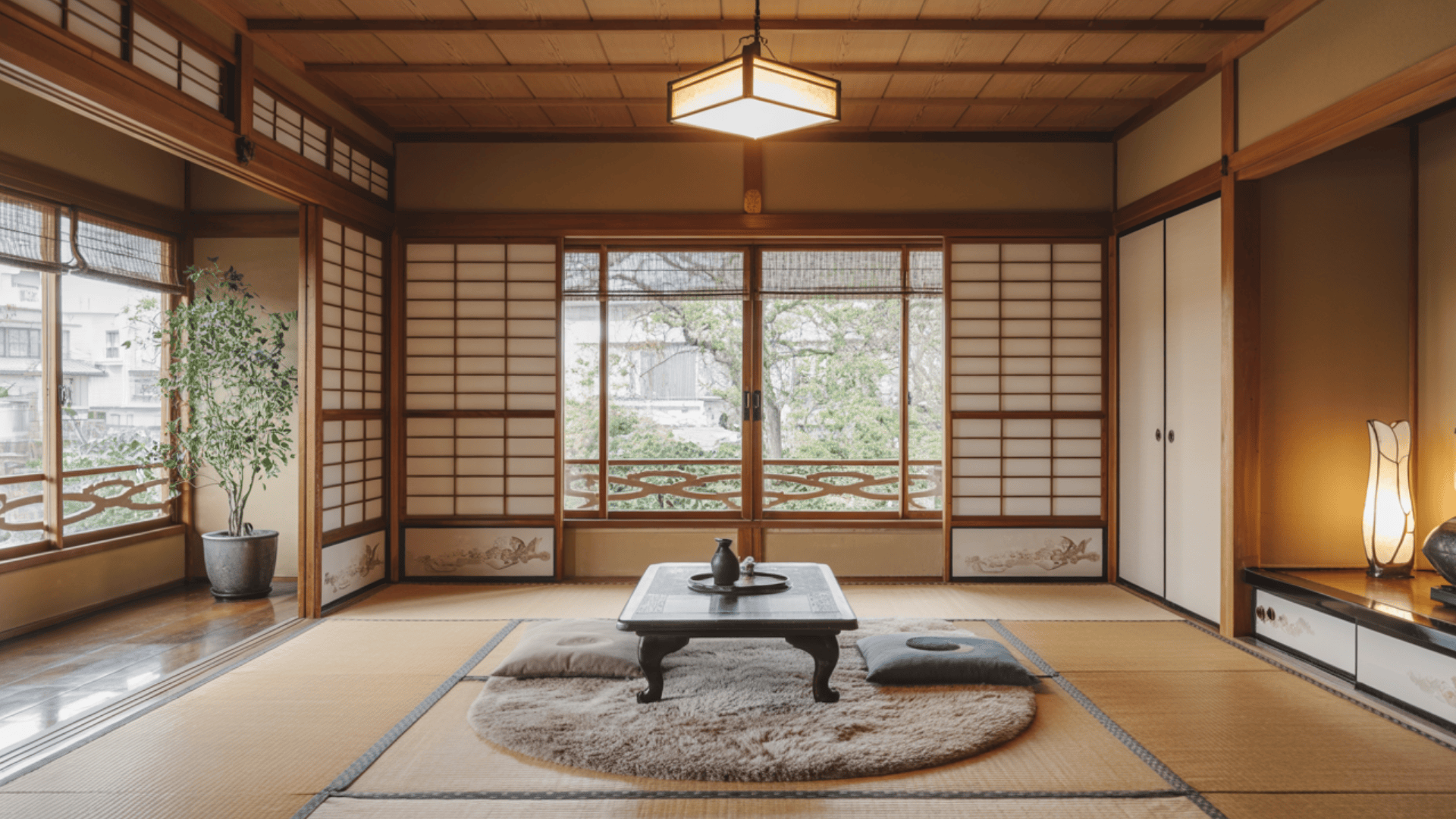
Start with a tatami mat as the base and layer a soft rug on top. Choose neutral or earthy tones to keep the look cohesive. The combination adds comfort and visual interest. It also helps define seating areas.
40. Monochrome Theme with Subtle Accents
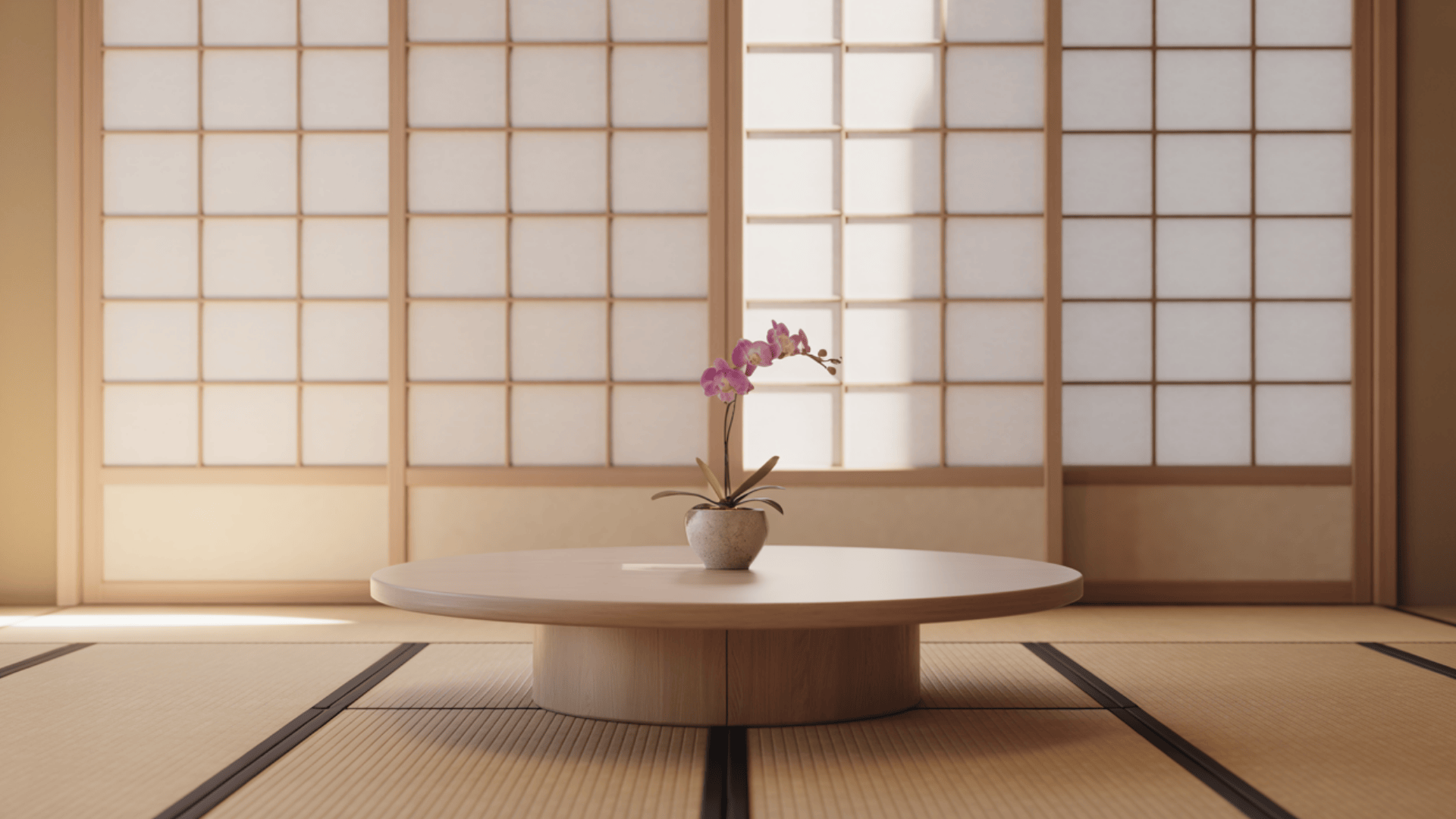
Stick to one main color throughout the room for a unified look. Add interest through texture and tone changes rather than bold contrasts.
Small accent pieces can bring variety without breaking the flow. This approach keeps the room peaceful and simple.
41. Recessed Shelving in Walls
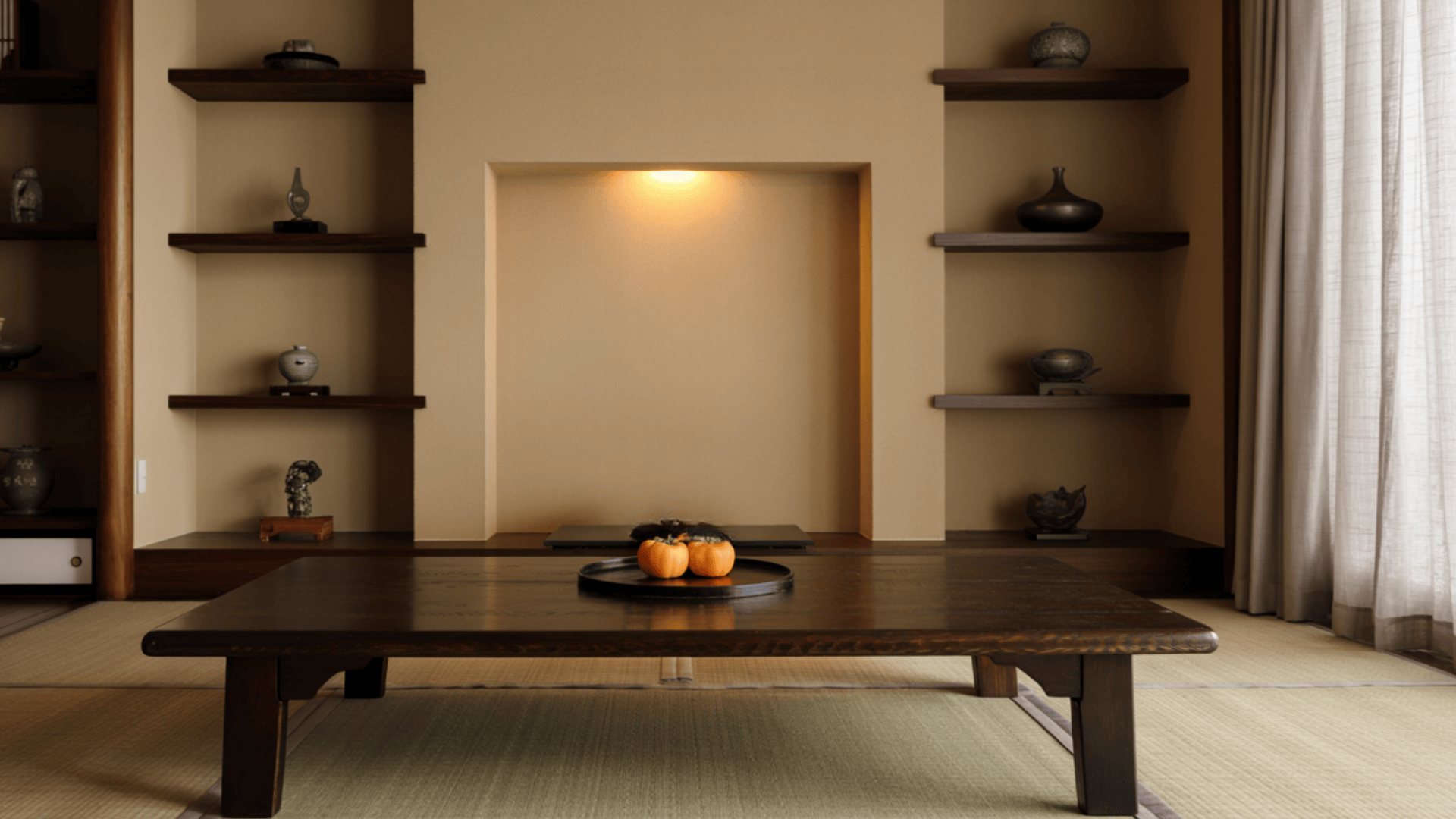
Recessed shelves provide storage without taking up floor space. Use them for books, plants, or pottery. Keep displays minimal to maintain an open feel. Add warm lighting inside the shelves to highlight decor pieces.
42. Floor-Level Reading Nook
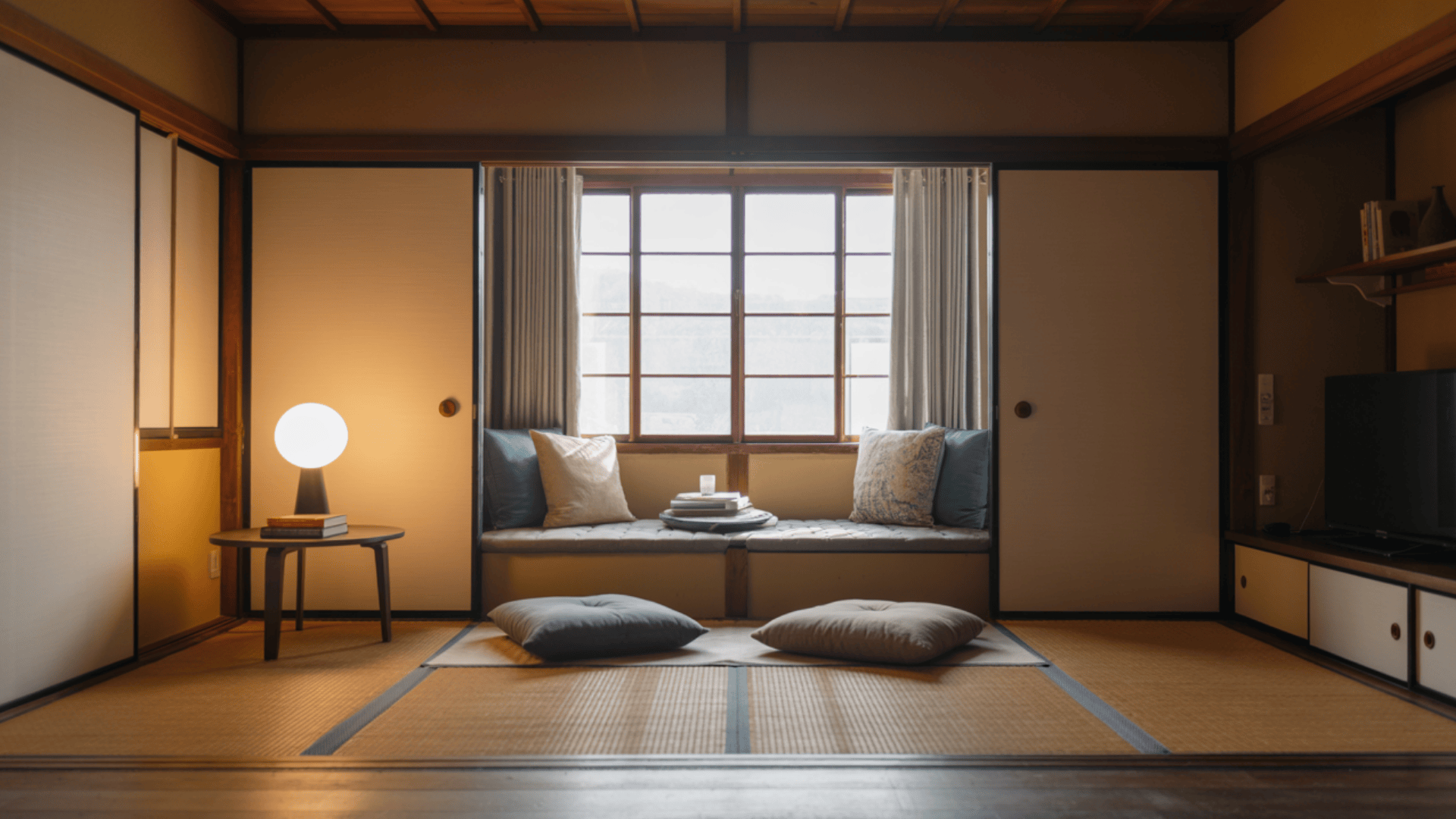
You can create a corner with a low bench or thick cushions. Place it near a window with good natural light.
Add a small side table for books or tea. You can also include a soft throw blanket for extra comfort.
Adding a potted plant nearby will bring a fresh, peaceful touch. This becomes a relaxing spot to unwind.
43. Seasonal Decor Changes
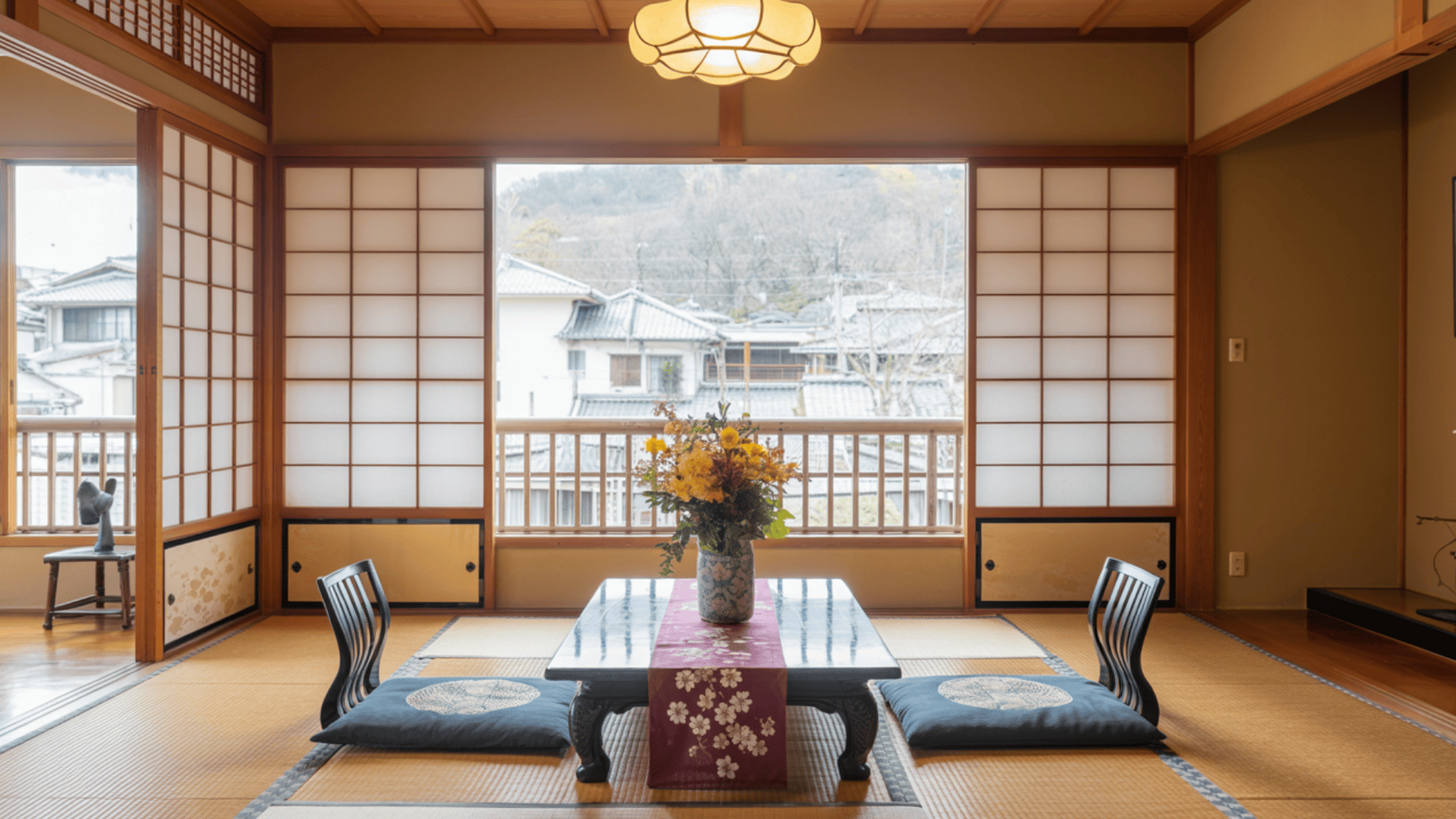
Swap textiles, plants, and small accents as the seasons change. Use light fabrics in summer and warm textures in winter.
This keeps the space feeling fresh without a complete redesign. It’s an easy way to keep the room visually interesting year-round.
44. Negative Space as a Design Feature
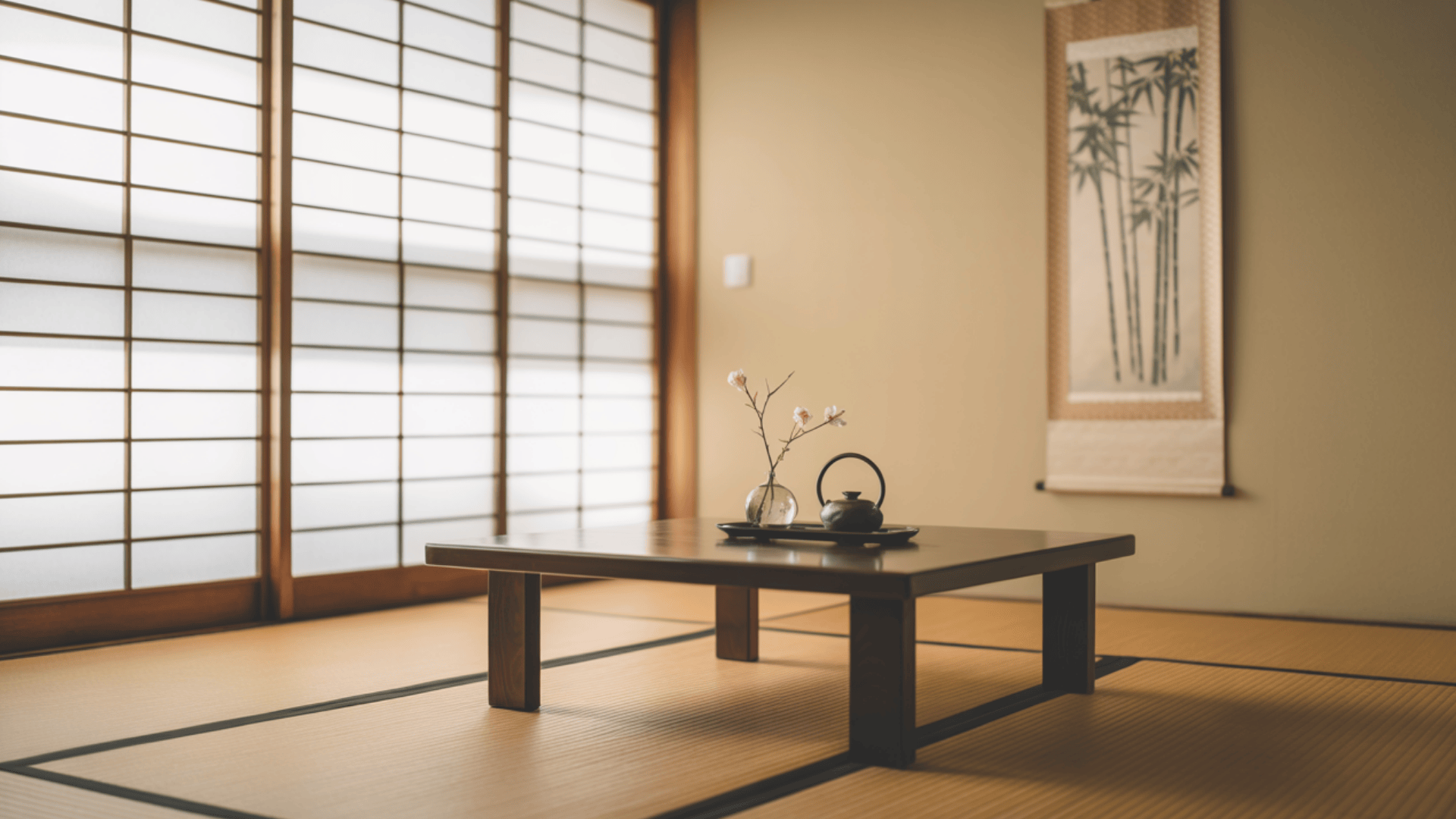
Leave certain areas intentionally empty to give the room breathing space. Avoid filling every wall or surface with decor.
This open space highlights the elements you choose to include. It adds balance and peace to the design.
45. Mixing Traditional and Modern Elements Mindfully
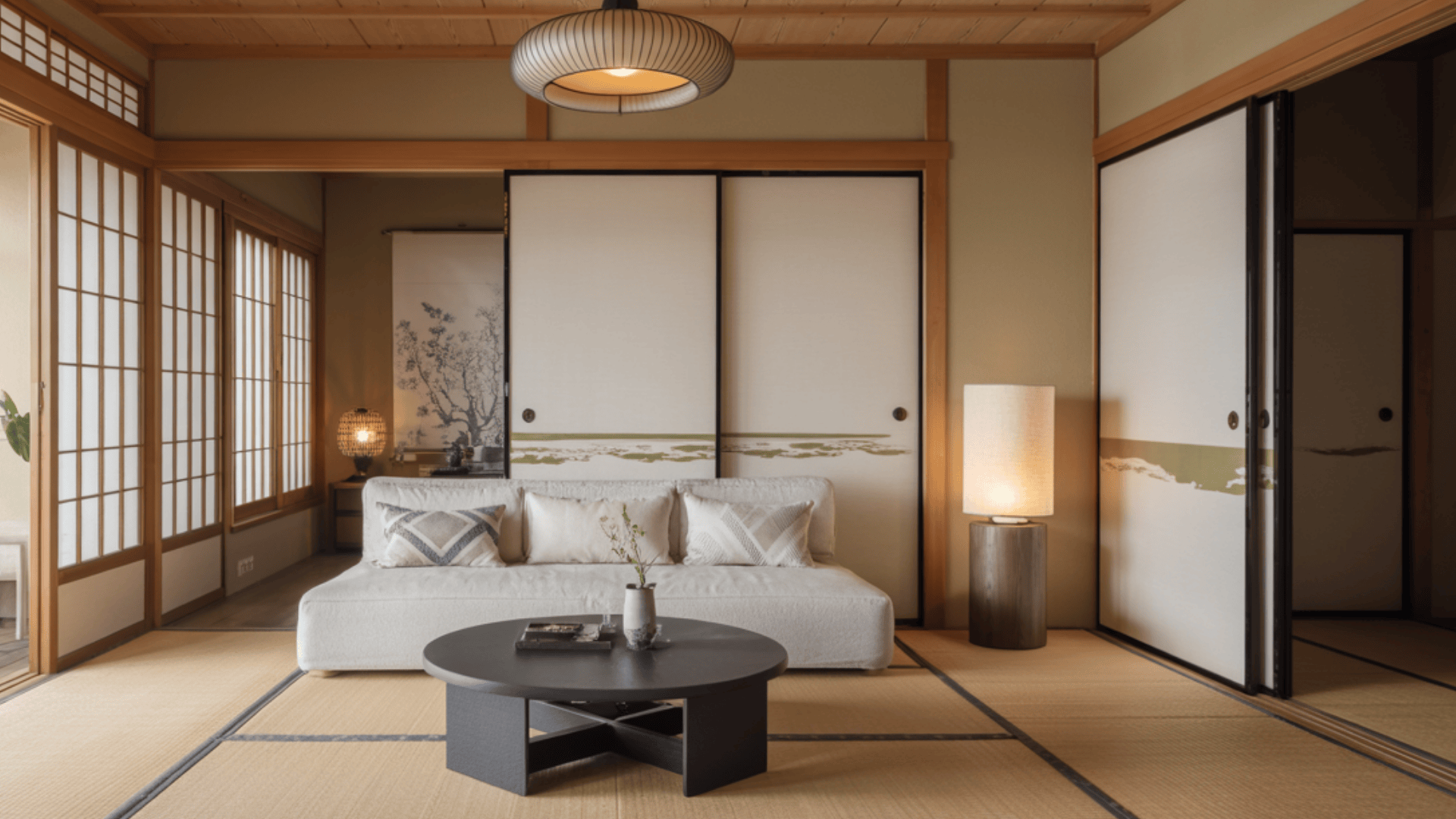
Combine tatami mats and shoji screens with modern lighting or furniture. Keep colors and textures consistent so the mix feels intentional.
The result is a space that honors tradition while feeling current. This balance can make your living room truly unique.
Maintenance & Care Tips
Regular upkeep helps a Japanese-style living room stay beautiful and functional for years. These tips will keep traditional features in great condition and ensure your space adapts well to seasonal changes:
- Vacuum Tatami Mats Weekly using a Brush Attachment to Remove Dust and Dirt without Damaging the Surface.
- Keep Tatami Mats Dry by Avoiding Spills and Using a Dehumidifier in Humid Months to Prevent Mold.
- Dust Shoji Screens Gently with A Feather Duster or Soft Cloth to Avoid Tearing the Paper.
- Clean Wooden Frames of Shoji Screens with A Slightly Damp Cloth, Taking Care Not to Wet the Paper.
- Rotate Textiles and Decor Seasonally by Using Lighter Fabrics in Summer and Adding Warmer Layers in Winter.
With these habits, your Japanese-style living room will stay fresh, comfortable, and true to its design year after year.
Conclusion
A Japanese-style living room is all about creating a peaceful, balanced space you can enjoy every day.
When I started using natural materials, a thoughtful layout, and simple decor, my living area became both beautiful and practical, and yours can too.
Now that you know the key principles and ideas, start adding elements that work for your home and lifestyle. Small changes can make a big difference over time.
If you found this helpful and want more tips on home design and decor, check out my other posts on the website for fresh inspiration and step-by-step advice to help you create a home you truly love!


